URBAN WALKS
OLD STREETS OF TAINAN
EXPERT TALK
GLASS ART IN HSINCHU


OLD STREETS OF TAINAN
EXPERT TALK
GLASS ART IN HSINCHU





The Guandu community, situated at the confluence of the Keelung and Tamsui rivers, is a popular destination for daytrippers, offering attractions such as the Guandu Nature Park, Guandu Temple, a riverside bikeway, old shops, and the recently opened Guandu Wharf Container Market. Visitors can easily access the area by taking the Taipei Metro to Guandu Station and then renting a YouBike at the station or a bicycle from the Taipei Riverside Bike Rental Center, located north of Guandu Temple. Guandu is connected to Taipei’s extensive riverside bikeway network, making it an ideal spot for cycling enthusiasts.
G Gua ndu Nat ure Park
Located just a 15-minute walk from MRT Guandu Station, the 57-hectare Guandu Nature Park is a haven for birdwatchers, especially from October to April, boasting over 300 bird species along with diverse wetland plants, fiddler crabs, and mudskippers. Visitors can explore nature trails, use birdwatching cabins, and visit the nature center. In November, the Guandu Flower Carnival takes place close to the park, featuring stunning fields of colorful flowers such as garden cosmos. These vibrant floral displays, set against the scenic backdrop of Mt. Guanyin and the Yangmingshan massif, offer excellent photo opportunities for visitors seeking to capture memorable moments in this natural wonderland.

The Guandu Wharf Container Market, opened in May, is part of Taipei’s efforts to connect riverbank areas with nearby neighborhoods. Inspired by the popular Dadaocheng Wharf Container Market, it features repurposed cargo containers housing food and beverage outlets. This family-friendly spot includes the Guandu Wharf (used for river cruises), a renovated fountain, and new play facilities. The market offers diverse local and international cuisine, including Western, Thai, Korean, Japanese, and Taiwanese options, with some vendors serving alcohol. Visitors can enjoy rooftop or ground-level seating, stunning sunset views over Mt. Guanyin, and regular live music performances, especially on weekends and holidays.
Experience the blend of natural beauty, cultural heritage, and modern attractions in Guandu for a perfect Taipei day trip! To learn more about Taipei and its many tourist attractions, read the TAIPEI quarterly magazine (see link below).


Dear Traveler,
Taiwan’s offshore islands are magical places, possessing culture, history, food, flora/fauna, and geography/geology a world apart from the big main island – and from each other. In our feature series of articles in this issue, we’re taking you to the islands of Kinmen, which float just off the mainland China coast.
In our main article, we head out on an entertaining and educative sortie through the historic villages of Kinmen, the archipelago’s largest island, which bristle with photogenic traditional architecture and impressive retired military fortifications.
In a second feature, you’ll spend an easy, slow-paced day on neighboring Little Kinmen, doing exotic things like experiencing decommissioned frontline forts, a subterranean military-tunnel network, a hybrid heritage soda factory/ museum, and the Little Kinmen specialty “bucket pastries in milk.” In a third article, we approach the islands from a novel angle, giving you four quintessential Kinmen themes to use for different day tours, perfect for getting you off the beaten tourist track: military tunnels, Wind Lion God statues, an important Eurasian otter colony, and the abundant local/ migratory birdlife.
Elsewhere, our wide-traveling writers will take you to the southwest coast city of Tainan, Taiwan’s oldest, to the northwest coastal city of Hsinchu, Taiwan’s center for glass manufacturing, and to the cosmopolitan capital, Taipei, in the north.
The theme in our regular Urban Walks department is a culture and history walkabout through the streets of Tainan's oldest quarter. Founded in the 1620s, Tainan was Taiwan’s imperial capital for over two centuries, leaving a priceless trove of heritage architecture, and recent decades have seen a deep cultural and economic renaissance.
In our Expert Talk article, From Shards to Showpieces, we spend time at a young attraction beside the Hsinchu City Glass Museum called Glass Studio + The Pool, established for visitors to try hands-on glassmaking and buy fine glass-art creations by talented designers.
And awaiting you in Good Food is the finest cup of coffee –or many – at elite Taipei cafés. As our writer says, there’s “no better way to understand Taiwan’s coffee culture than to explore some of its most renowned cafés, from worldchampion brewers and baristas to purveyors of Taiwanorigin beans.”
Enjoy our home! And know that wherever your Taiwan traveling takes you, the locals await with a Welcome! and a smile.

台灣觀光雙月刊
Travel in Taiwan
The official bimonthly English magazine of the Taiwan Tourism Administration (Advertisement) SEPTEMBER/OCTOBER, 2024 Tourism Administration, MOTC First published Jan./Feb. 2004 ISSN: 18177964 GPN: 2009305475 Price: NT$200
中華郵政台北雜字第1286號執照登記為雜誌交寄 Copyright @ 2024 Tourism Administration. All rights reserved. Reproduction in any form without written permission is prohibited.
MAGAZINE IS SOLD AT:
1. Wu-Nan Culture Plaza, No. 6, Zhongshan Rd., Central Dist., Taichung City 40043 886-4-2226-0330 http://www.wunanbooks.com.tw/
2. National Bookstore, 1F., No. 209, Songjiang Rd., Zhongshan Dist., Taipei City 10485 886-2-2518-0207 http://www.govbooks.com.tw/
PUBLISHER
Taiwan Tourism Administration
EDITING CONSULTANT
T. C. Chou
PUBLISHING ORGANIZATION
Taiwan Tourism Administration, Ministry of Transportation and Communications
CONTACT
International Division, Taiwan Tourism Administration Add: 9F, 290 Zhongxiao E. Rd., Sec. 4, Taipei City, 10694, Taiwan
Tel: 886-2-2349-1500 Fax: 886-2-2771-7036
E-mail: tad@tad.gov.tw Website: http://taiwan.net.tw
PRODUCER
Vision Creative Marketing & Media Co.
ADDRESS
1F, No. 5, Aly. 20, Ln. 265, Sec. 4, Xinyi Rd., Taipei City 10681, Taiwan
Tel: 886-2-2325-2323 Fax: 886-2-2701-5531
editor@v-media.com.tw
GENERAL MANAGER
David Hu
EDITOR IN CHIEF
Johannes Twellmann
ENGLISH EDITOR
Rick Charette
DIRECTOR OF PLANNING & EDITING DEPT
Joe Lee
MANAGING EDITOR
Anna Li
EDITORS
Masako Takada, Ruby Chang
CONTRIBUTORS
Ami Barnes, Rick Charette, Jenna Lynn Cody
PHOTOGRAPHERS
Chen Cheng-kuo, Ray Chang, Alan Wen, Powei Chen
DESIGNERS
Ian Tsai , Hsieh Yun-jhen , Nina Yang
ADMINISTRATIVE DEPT
Lily Wan, Hui-chun Tsai, Xiou Mieng Jiang
ABROAD
Offices of the Taiwan Tourism Administration in Beijing, Shanghai, Hong Kong, Singapore, Bangkok, Ho Chi Minh City, Kuala Lumpur, Seoul, San Francisco, New York, Los Angeles, Frankfurt, and London. Overseas Offices of the Ministry of Economic Affairs; Overseas Offices of the Central News Agency; EVA Air, and other selected international airlines; selected travel agencies in Asia, North America, and Europe; and other organizations.
IN TAIWAN
Tourism Administration Visitor Center; Tourism Administration; Taiwan Visitors Association; foreign representative offices in Taiwan; Tourism Administration service counters at Taiwan
Taoyuan Int’l Airport and Kaohsiung Int’l Airport; major tourist hotels; Taipei World Trade Center; VIP lounges of international airlines; major tourist spots in Taipei; visitor centers of cities and counties around Taiwan; offices of national scenic area administrations; public libraries
This magazine is printed on FSC® COC certified paper. Any product with the FSC® logo on it comes from a forest that has been responsibly maintained and harvested in a sustainable manner.
This magazine was printed with soy ink. Soy ink is said to be more environmentally friendly than petroleum-based ink and to make it easier to recycle paper.
ONLINE
Read Travel in Taiwan online at www.travelintaiwan.net. Find back issues (PDF version) on the publication platform issuu at issuu.com/travelintaiwan





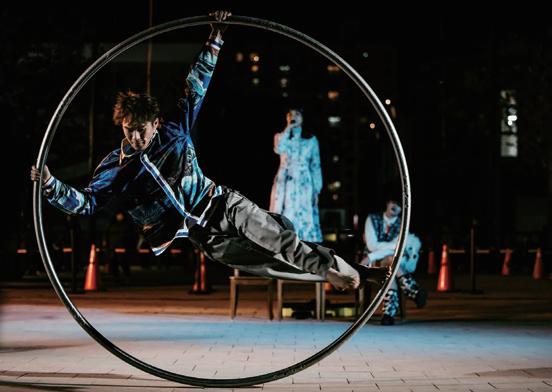



TAIPEI CITY 1
October 5/6
Nuit Blanche, a global nighttime urban art festival, originated in Paris in 2002. Now held annually in over 30 cities worldwide, it combines contemporary art, offers urban perspectives, and addresses community issues. Endorsed by the Paris City Government, Taipei has hosted its edition of this party-like event since 2016, emphasizing immersive cultural experiences while showcasing the capital’s cultural vitality. www.facebook.com/nuitblanchetpe nuitblanche.taipei NUIT
TAIPEI CITY 2
October 25~28
Art Taipei, established in 1992, is Asia’s longestrunning international art exhibition and Taiwan’s primary art market platform. Organized by the Taiwan Art Gallery Association and supported by the central government, it annually showcases about 150 domestic and international galleries. The fair exhibits quality contemporary artworks from established and emerging artists, elevating Taiwan’s art industry and cultivating new collectors. 2024.art-taipei.com/taipei/tw
CHIAYI COUNTY 3
October 5 ~ November 3
NPM ASIAN ART FESTIVAL –OKINAWA MONTH
故宮亞洲藝術節—日本沖繩月
The NPM Asian Art Festival, held annually since 2017 at the Southern Branch of the National Palace Museum, spotlights a different Asian culture each year. Complementing Asia-themed exhibitions, it offers interactive games, costume experiences, art performances, and lectures. India, Singapore, and South Korea have been among the countries featured to date, and Japan’s Okinawa islands will be the festival focus this year.
south.npm.gov.tw
Nov. 9 ~ Dec. 1 TAICHUNG CITY 4
TAICHUNG INTERNATIONAL FLOWER CARPET FESTIVAL
新社花海暨台中國際花毯節
The annual Taichung International Flower Carpet Festival, central Taiwan’s premier celebration of floral beauty, showcases Taichung's floriculture and tourism. The spectacle features a mesmerizing expanse of colorful cosmos flowers surrounded by sunflowers and sun hemp, with visitors exploring the fields following winding paths through the blooms. Xinshe District also offers cycling and mushroom foraging opportunities, appealing to nature lovers year-round.
travel.taichung.gov.tw
TAIPEI CITY 5 September ~ October
臺北時裝週
Taipei Fashion Week, co-organized by the city government, Ministry of Culture, and Ministry of Economic Affairs, is about celebrating fashion and promoting both local and international designers. The yearly event features fashion shows, street exhibitions, forums, and pop-up shops, making high fashion accessible to everyone and sprucing up the city’s modern look.
tpefw.com


TAITUNG COUNTY 6 October 26/27
池上秋收稻穗藝術節
First held in 2009, the Chishang Autumn Rice Harvest Arts Festival is an open-air performing arts event staged annually in a picturesque rice field in Chishang, a Taitung township renowned across the island for its high-quality rice. What began as a simple piano recital for a small audience has evolved into a large-scale event with a 2,500-seat grandstand and a spacious stage. Over the years it has hosted performances by some of Taiwan’s most renowned acts, including Cloud Gate Dance Theatre and pop star Kulilay Amit (A-Mei).
tour.taitung.gov.tw



The year 2025 will mark another milestone in Taipei’s sporting history. Following the successful hosting of the 2009 Deaflympics and the 2017 Summer Universiade, Taipei City, in collaboration with New Taipei City, will welcome the World Masters Games.
Held quadrennially, this is a multi-sport event – governed by the International Masters Games Association – that is designed for athletes of all abilities, primarily aged 35 and older. What sets these games apart from large-scale sporting events like the Olympics is their inclusivity and scale, with participants competing as individuals rather than representing countries.
The Taipei games are expected to attract around 30,000 athletes from across the globe, competing in 35 diverse sports, showcasing the games’ unique blend of competitive spirit and accessibility. Among the sports – team and individual –are very common ones, such as athletics, football (soccer), and weightlifting, as well as a number of more unusual ones, including flying disc, orienteering, and surf lifesaving. There will be 69 venues, primarily located in Taipei City and New Taipei City. Additional venues will extend to Taoyuan City, Hsinchu City/County, and Yilan County.
Since its inception in Toronto in 1985, the World Masters Games has been hosted by various cities worldwide. The 2009 Sydney edition set a remarkable participation record, attracting 28,676 competitors – more than double the number
of athletes in the 2000 Sydney Olympics. The games have also become a magnet for retired professional athletes and former Olympians, with hundreds participating each time.
The most recent edition, the ninth World Masters Games, took place in Auckland, New Zealand in 2017. The global pandemic forced the cancellation of the 2021 event, making the upcoming Taipei games, scheduled for May 17-30, 2025, even more highly anticipated.
Official registration for the event opened in February this year, and sports enthusiasts worldwide are invited to participate. The Taipei City Government’s Department of Sports emphasizes that the event champions “lifelong sports” and “sports for all” athletes, providing them with the unique opportunity to compete internationally without having to undergo a selection process.
Those interested can register (until February 17, 2025) individually or form teams with both local and international athletes. Citizens and foreign residents of Taiwan are eligible for registration discounts. Registration fees vary based on documentation, with special rates for holders of ROC passports and ID cards, National Health Insurance cards, or Alien Resident Certificates (ARCs).
For more information about the World Masters Games, including registration, visit the official website at wmg2025.tw.
The narrow urban north section of Taipei City’s Nangang District used to have a distinct industrial character, dominated by a plant operated by tire giant Nankang Rubber Tire (the plant was demolished in 2008). Today, the district is increasingly dominated by sleek high-rise apartment buildings both recently completed and currently being built around the Taiwan Railway/MRT Nangang Station complex and the futuristic structures of the Taipei Music Center, unveiled in 2020.
This center, designed by New York-based architecture firm Reiser + Umemoto, has three distinct buildings, the Concert Hall, the Cultural Cube, and the Creative Hub. Among these structures, the Concert Hall stands out with its 5,000-seat capacity and state-of-the-art facilities. Its clamshell-shaped pleated roof is meant to resemble Taiwan’s soaring chains of mountains. The Cultural Cube has a much simpler appearance, but features some intriguing details on its façades, including the protruding staircase of the building; it is Taiwan’s first exhibition hall dedicated to the island’s rich pop music history. The Creative Hub building, which resembles a shiny precious stone, serves as a creative sanctuary for artists to refine their skills.
The long plaza between the Creative Hub and the Cultural Cube can accommodate up to 3,000 people and serves as a venue for open-air concerts, street art performances, markets, and other music-related events. It is flanked by stores and restaurants inside two narrow buildings on the north and south sides. There are also stores (vinyl records, audio equipment, etc.) and bars on the ground floors of the Cultural Cube and Creative Hub, as well as four Live House venues accommodating between 200 and 1600 people.
If you would like an introduction to the history of Taiwan’s pop music, a visit to the permanent exhibition (admission NT$350) in the Cultural Cube is highly recommended. The experience feels remarkably immersive when listening to your audio guide, teasing your ears with well-recorded commentary and a bounty of old songs. For those who grew up in Taiwan or spent significant time here during pre-cellphone, pre-Internet, and even pre-cableTV times, this exhibition brings back vivid memories of watching televised weekend variety shows and listening to pop music recorded on vinyl records and cassette tapes. For
ENGLISH AND CHINESE
Concert Hall 表演廳
Creative Hub 產業區
Cultural Cube 文化館
Nangang District 南港區
Nankang Rubber Tire 南港輪胎
those unfamiliar with those times, the introductions are very informative and the exhibits are visually appealing.
On September 7-8, the Taipei Music Center will enter a new era as it transforms into the beating heart of TRENDY TAIPEI, a festival set to invigorate the city’s cultural landscape. This event will ignite every corner of the venue – from the majestic Concert Hall to the electrifying Live House and the vibrant plaza. TRENDY TAIPEI @Taipei Music Center aims to spotlight Taiwan’s pop music scene while serving as a catalyst for the growth of its music industry. Featuring over 70 acts from across Asia, TAIPEI MUSIC EXPO, JAM JAM ASIA, and Taipei Music NonStop will immerse you in Taipei’s red-hot music scene like never before!


TAIPEI MUSIC CENTER ( 臺北流行音樂中心 ) (02) 2788-6620
No. 99, Sec. 8, Civic Blvd., Nangang District, Taipei City ( 台北市南港區市民大道 8 段 99 號 ) www.tmc.taipei

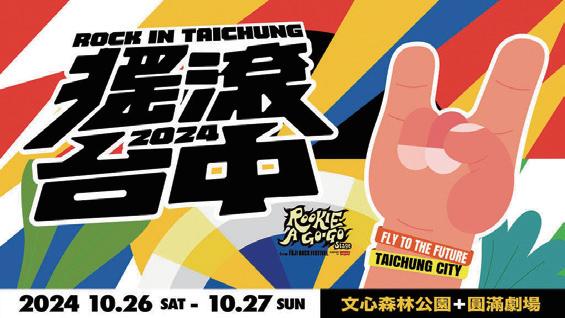

Exhibition
梵谷:尋光之路
Fubon Art Museum ( Taipei City ) 1
August 24 ~ November 11
Celebrating the 170th birthday of Van Gogh, Journey of Light features 25 rare works from the KröllerMüller Museum in the Netherlands, including selfportraits and pieces from the artist’s Arles period. Visitors can experience Van Gogh’s brilliant colors and post-Impressionist style firsthand. The Dutch museum, founded by early Van Gogh collector Helene Kröller-Müller, houses such famous works by the master painter as Café Terrace at Night. The Fubon Art Museum is a new art venue designed by Renzo Piano that opened this May. www.fubonartmuseum.org
Concert 2
October 26/27
Wenxin Forest Park ( Taichung City )
The Taichung Rock Festival, initiated in 2008 by the Cultural Affairs Bureau of the Taichung City Government, is one of Taiwan’s premier rock events. With the main stage set up at the Fulfillment Amphitheater inside Wenxin Forest Park, the festival showcases both local and international talent. This year the music celebration is collaborating with Japan’s renowned Fuji Rock Festival. This partnership brings an exclusive new stage, recreating the famous ROOKIE A GO-GO Stage from Fuji Rock. The event will feature electrifying performances by four up-and-coming Japanese bands – Ålborg, DNA GAINZ, SPENSR, and Mizuki – as well as the popular Japanese pop ensemble New Tokyo. www.taichung.gov.tw
Exhibition 3
POP! POP! POP! AN INTERACTIVE JOURNEY POP! POP! POP! 流行音樂互動展
July 17 ~ January 12, 2025
Kaohsiung Music Center ( Kaohsiung City )
POP! POP! POP! An Interactive Journey is the first exhibition at the Kaohsiung Music Center. It offers a comprehensive exploration of Taiwan’s pop music history. A highlight of the exhibition is the Sounds of the South section, which introduces the rich musical and cultural heritage of Taiwan’s south region. This section features interactive sound installations incorporating keywords chosen by visitors, representing the unique auditory landscape of south Taiwan. kpmc.com.tw



臺中爵士音樂節
October 10 ~ 31
Taichung Civic Square ( Taichung City ) Music 4
The highly anticipated Taichung Jazz Festival is marking a significant milestone this year – its 20th anniversary. Held in the city’s heart at Taichung Civic Square in the West District, this annual event draws large crowds of music lovers each year. The festival transforms the square into a grand open-air celebration, with spectators sprawling across the lawn, immersing themselves in an eclectic array of jazz styles performed by accomplished musicians from Taiwan and abroad.
www.taichungjazzfestival.tw
瞬間-穿越繪畫與攝影之旅
June 29 ~ November 17
Kaohsiung Museum of Fine Arts ( Kaohsiung City ) Exhibition 5 5 6 4
Capturing the Moment, curated by Gregor Muir and Beatriz Garcia-Velasco, explores the interplay between painting and photography from the mid-20 th century onward. The exhibition features 55 works from the Tate collection and the YAGEO Foundation, showcasing how artists across mediums capture fleeting moments and crystallize them into enduring representations of life and history. Drawing on Susan Sontag’s observation that “the painter constructs, the photographer discloses,” the exhibition highlights the dynamic relationship between these art forms in modern art history.
www.kmfa.gov.tw
落日月台
Until March 2025
Songshan Cultural and Creative Park ( Taipei City ) Exhibition 6
This exhibition offers a captivating journey into an imaginative realm, inviting visitors to engage with and explore a richly interactive fantasy space. The 70-80min experience transports participants through eight distinct chambers, each brought to life by costumed performers embodying elemental forces: light, fauna, earth, flora, water, fire, minerals, wind, and darkness. The immersive journey invites reflection on the transient nature of existence, guiding participants to confront mortality and contemplate life’s meaning through a transformative sensory experience.
www.songshanculturalpark.org

Well over a millennium of settlement and decades of military conflict in the 20th century have endowed Kinmen – Taiwan’s largest outlying island – with a unique blended culture and a landscape where battle scars coexist alongside quiet villages full of exquisite traditional architecture. Just an hour’s flight from Taipei, Kinmen presents travelers with an unconventional and unforgettable getaway.

At first glance, Kinmen may appear a strange choice for a vacation. Far closer to China than to Taiwan, the archipelago (“Kinmen” is used to refer to both the largest island and the archipelago) rarely garners headlines save for occasional flare-ups between the coast guards and fishing vessels of the two sides. It lacks the beach culture of the islands of Penghu or Xiaoliuqiu, and there’s none of the lush high-hill scenery found on outlying islands such as the Matsu Islands, Orchid Island, and Green Island. However, for a certain kind of traveler – the ones who seek the uncurated or unusual, the ones who cherish the unfettered freedom of roaming through historic villages searching for characterful local folk deities, battlefield relics, and living rooms that double up as restaurants – Kinmen is an island paradise.

One of the first things you notice upon arriving in Kinmen is the wealth of historic buildings. The archipelago’s architectural blend is strikingly different from that of Taiwan proper – southern Fujian-style dwellings in varying states of polishedness are ten a penny, and scattered among them are buildings bearing clear European influences. Nicknamed yanglou or “Western-style houses,” these structures are testament to the complex interplay of economic needs, political currents, and personal aspirations that once swirled around the Fujianese coastline.
The village of Shuitou is a good starting point for those interested in getting a basic primer on the whats, whys, and hows of the islands’ architectural heritage. It is home to buildings that exemplify the range of Kinmen architecture, as well as a museum that offers insight into how – at the turn of the twentieth century –this region ended up so awash with money that the locals were all competing to build grand mansions.
Deyue Tower and Huang Huihuang Mansion are two of Shuitou’s more striking structures. They were built in the early 1930s to the specifications of Huang Huihuang, a Kinmen businessman who amassed his wealth in Indonesia. The tower was both a deterrent and defense against bands of pirates that plied the region’s waters, but far from being purely utilitarian, its protective design was augmented with aesthetic appeal – note the decorative (and nationalistic) moldings framing its embrasures, and lintels shaped like draped ribbonry.
A tunnel connecting the tower to the main house and a row of decoy half-houses immediately behind the tower were intended to give the Huang family time to flee in the event of a raid. Even the fake houses are pretty, but Huang’s mansion takes the concept of decorative construction up a notch or two. Wherever you look, the two-story brickand-stone structure reveals some new detail to catch your eye. Banks of majolica tiles flank the main entrance, the brickwork is embellished with propitious seal script characters, and depictions of elephants and other symbolic totems adorn the cornice, while the interior living spaces are punctuated by skywells.


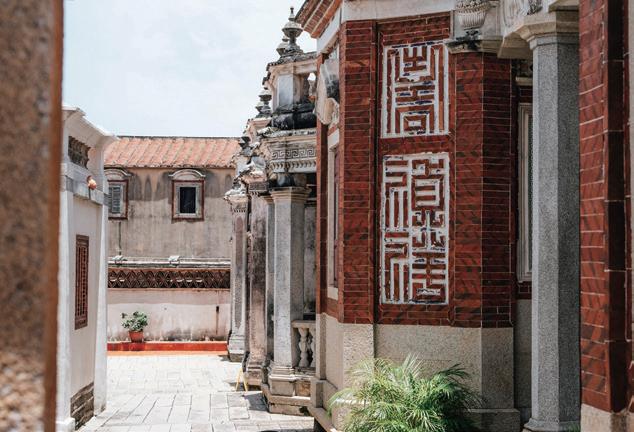


Nearby, in the Overseas Chinese Cultural Exhibition Hall , you’ll learn that Huang’s life trajectory was not a million miles away from that of his contemporaries. After the First Opium War ended in defeat for China, the Port of Xiamen – Kinmen’s nearest large port – was opened to foreign trade, precipitating a wave of emigration from the region. Much of the Kinmen diaspora found labor in Southeast Asian colonies of European foreign powers, and over time, some parlayed their areas of expertise into positions of higher standing and started sending remittances back home.
This inflow of money meant families of those who worked overseas were better off than their neighbors. And when the adventurers returned to Kinmen – flush with cash and possessing a newfound taste for the flourishes of colonial architecture – they had no aversion to displaying their newfound riches by constructing elaborately embellished houses. It was this that drove the small explosion in yanglou buildings in the 1920s and 1930s.
The museum’s bilingual displays explain that a good yanglou incorporated a range of design elements borrowed from the European colonial architecture playbook. Verandas were popular – styled on the “five-foot way” covered walkways seen in Singapore and Malaysia. Columns were commonplace, and intricate pediment ornamentation allowed craftspeople to really show off their skills. Design motifs from both East and West were liberally incorporated, meaning that dreamy cherubs rub shoulders with Asian dragons, while shields and lions rampant join lotus flowers and carp.

DEYUE TOWER ( 得月樓 ) (082) 321-103
No. 45, Qianshuitou, Jincheng Township, Kinmen County ( 金門縣金城鎮前水頭 45 號 ) 8:30am~5pm Free
OVERSEAS CHINESE CULTURE EXHIBITION HALL ( 僑鄉文化展示館 ) (082) 313-281
No. 39, Qianshuitou, Jincheng Township, Kinmen County ( 金門縣金城鎮前水頭 39 號 ) 8:30am~5pm Free

Many of Kinmen’s historic buildings have been carefully renovated and put into service as homestays and B&Bs. In mainland Taiwan, there are few places where you can stay in a century-old dwelling, but on Kinmen, you have multiple quality options in almost every village.
During a recent visit, Travel in Taiwan had the pleasure of staying in one such historied building, Shuitou Guyanglou Homestay. The property is a southern Fujian-style courtyard home nestled within the settlement of Shuitou – just a 2min walk away from Deyue Tower. As mentioned earlier, Shuitou has a reputation for
being home to a spectacular blend of Fujian- and Western-influenced architecture. Indeed, a pithy local saying holds that “even all the riches in the world can’t buy you a house as fine as those in Shuitou,” and Shuitou Guyanglou Homestay is something of a compilation of all the village’s best bits.
The front door sits in the center of a single-story brick and stone building topped with characteristic swallowtail eaves. In the daytime, the heavy wooden doors stand open, with just a thigh-high gate across to deter members of the public from wandering in, and to either side of the doorway, the most
exquisite array of majolica tiles is displayed in symmetrical arrangement. Such tiling – considered an indicator of wealth and sophisticated style – was a common feature of houses throughout Kinmen, but you’d be hard-pressed to find another building bestowed with such a well-preserved bounty of glaze work. In fact, Guyanglou’s veritable garden of floral and other nature-inspired geometric designs is so admired that the building has been nicknamed “Kinmen’s Tile Museum.”
Stand back a little further and you’ll notice the gable end of an outer wing, and behind that a compact two-story




yanglou complete with a balcony framed by elegant brickwork columns and arches. This latter area is maintained for use by homestay staff, while the largest suite (accommodating up to six) is found in the side wing. There are also two more twin rooms, located on either side of the main entrance.
The rooms are sparsely furnished with decoration kept to a minimum, allowing the masterful simplicity of the warm terracotta tiles, white walls, and earth-tone woodwork to stand out. Luckily, simplicity does not preclude comfort – I enjoyed some of the soundest sleep that I’ve had in months, roused only by the exuberant chirruping of the dawn chorus.
In addition to the bedrooms, there are a couple of communal spaces where guests can relax and recuperate following long days spent exploring. A table stands in the central courtyard, which is attached to a small but functional kitchen – perfect for anyone who fancies rustling up a homestyle breakfast (the nearest supermarket is about a 10min drive away) or spending one’s evening stargazing accompanied by a glass of the finest local fire water, Kinmen Kaoliang (a sorghum spirit). There’s also a larger indoor seating area in the rear hall, where gods and ancestral tablets preside over a collection of books on the region’s flora, fauna, and other sights.
For guests who prefer a more secluded getaway, the neighboring Kinmenhouse Villa No. 7 would be a good choice. Located just across the way from the main building of Shuitou Guyanglou Homestay, this separated annex comes complete with its own kitchenette and can comfortably accommodate a family with its combination of single beds and tatami-style sleeping areas.
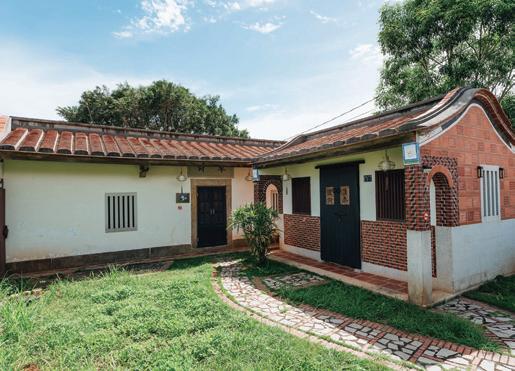
SHUITOU GUYANGLOU HOMESTAY ( 水頭古洋樓花磚民宿 )
No. 4, Qianshuitou, Jincheng Township, Kinmen County ( 金門縣金城鎮前水頭 4 號 ) www.facebook.com/guyanglou www.instagram.com/guyanglou
KINMENHOUSE VILLA NO.7 ( 水頭舒宅 )
0933-318-498
No. 7, Qianshuitou, Jincheng Township, Kinmen County ( 金門縣金城鎮前水頭 7 號 )
Five kilometers due north of Jincheng, Kinmen’s largest settlement, is Guningtou – a part of Jinning Township encompassing the villages of Nanshan, Beishan, and Lincuo.
For much of its 800-year history of habitation, the area’s residents lived simply, in sync with the rhythms of tides and weather as they farmed rice, harvested salt, and cultivated oysters. This peace was shattered in October 1949 when the Chinese People’s Liberation Army (PLA) launched an ill-fated attempt to seize Kinmen from Republic of China (ROC) Nationalist forces – making Guningtou the only place on ROC soil to have
witnessed the deaths of soldiers from both sides. More recently, it has achieved further renown for an unlikely Instagram hotspot –Beishan Broadcasting Wall , a townhouse-sized wall of speakers and a weapon of psychological warfare used for blasting pop songs and antiCommunist propaganda across the waters to the other side.
One way to comfortably see this area’s highlights is by hopping aboard one of the twice-daily Guningtou Electromobile Tours departing from the Guningtou Electromobile Tour Service Center. The tours take in sites illuminating the area’s military
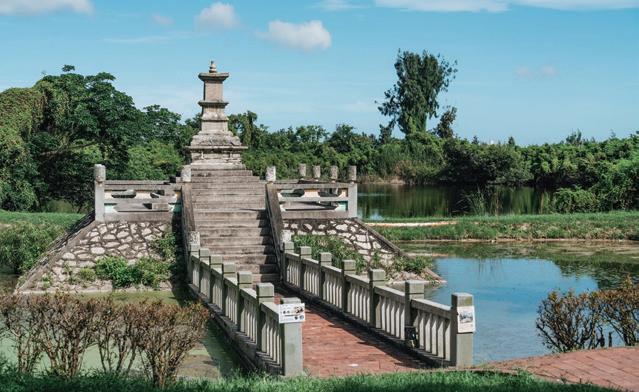

significance as well as locations with cultural or ecological interest (booking required).
Cultural stops include two protective talismans, the Beishan Wind Lion and Shuiwei Pagoda , as well as Guandi Temple – all of which are clustered around Shuangli Lake At one time, this lake was more of a lagoon. Boats could sail through – what is now – Lake Ci to dock in Guningtou, and where Guandi Temple sits today there was an earlier temple iteration perched atop a sandbar and accessible only at low tide. The two low-rising hills flanking the lagoon’s innermost tip seemed to


twist towards the temple in a manner that made poeticminded locals think of twin carps reaching to greet a pearl – giving rise to the name Shuangli Lake (literally, “two carp lake”).
The e-vehicle tour also pauses at the nearby Shuangli Wetland Nature Center. The upper floor of this split-level facility includes introductions to the region’s geology, changing landscape, and birdlife (top billing goes to the charmingly be-mohawked hoopoes), while downstairs are displays devoted to intertidal ecology, horseshoe crabs, and the island county’s beloved Eurasian otter population (see page 31). Another of the tour’s stops bearing ecological interest is the Beishan Seawall , outside which the majority of Kinmen’s oysters are reared. At low tide, forests of granite posts poke out of the exposed mud against the distant backdrop of Xiamen’s innumerable skyscrapers, tended to by oyster farmers for generations.
The remainder of the tour stops are locations with military import. There’s the aforementioned Beishan Broadcasting Wall and the Guningtou Battle Museum , where large-scale oil paintings recount scenes from the frontline. But by far the most viscerally impressive of these tourist stops is the Beishan Western-style House
This intriguing structure presents different faces depending on which side you look at. From the main road, it’s an attractive – if dilapidated – example of yanglou architecture, but venture down the village lane on the left side and you’ll find it abuts a renovated southern Fujian-style house – now housing a backpacker hostel.
During the Battle of Guningtou, PLA fighters who survived the first night after reaching the shore pushed inland, taking cover among the coastal settlements. Without reinforcements, the troops’ rapidly exhausted

rations and ammunition supplies sealed their defeat. Most were captured or killed, but those holed up in today’s Beishan Western-style House refused to surrender despite the vicious onslaught of gunfire. The siege ended in the suicide of the PLA soldiers and left pockmarks tattooed across the exterior white-plaster walls – a ghoulish sight that invites you to probe the wounds, both literally and figuratively, as you imagine the terror that once darkened this now peaceful village.
GUNINGTOU ELECTROMOBILE TOURS ( 古寧頭電瓶車遊程 )
Departures: 8:30am, 2:20pm
Duration: 90min
Max. number of passengers: 13 NT$250 (082) 321-721 kinmen.travel/en/discover/tour/44
BEISHAN WESTERN-STYLE HOUSE BACKPACKER INN ( 古洋樓背包客棧 ) No. 46-5, Beishan, Guning Village, Jinning Township, Kinmen County ( 金門縣金寧鄉古寧村北山 46-5 號 )

The historic core of Jincheng – Kinmen’s main town – is a roughly 2kmsquare wedge that’s encircled by Minquan/Minzu/Minsheng roads and home to an impressive assortment of monuments. Tight, winding lanes and densely packed sights make the area ideal for navigating on foot, with a morning or afternoon giving ample time for thorough exploration.
The route we took started from the beating heart of any town – its morning market. Scooters slalomed their way between vendors and pedestrians while breakfasters devoured steaming bowls of Guangdong congee, seemingly oblivious to both the noise and heat. Swept along by the flow, we soon found ourselves standing before the Chastity Arch for Qiu Liang-gong’s Mother
The finely carved stone structure was commissioned in 1812 by military officer Qiu Liang-gong. Qiu’s father died a month after his birth, but rather than seeking the swift financial safety net of remarriage, his mother honored her marriage vows by remaining single and raising Qiu alone. Women of that era had few avenues through which to support themselves (and fewer still that would see their deeds commemorated in stone), so the fact that she raised him not just adequately but well enough to support his ascension through the military ranks was no mean feat. In modern parlance, you could say this is a tribute to a devoted single mother’s hard work and loving care.
It’s worth pausing to enjoy the archway’s intricate stonework. In particular, of the eight guardian lions, note the lone lioness painted jade green. She is said to be the queen of Kinmen’s wind lions (see page 30), and the street’s appreciative market vendors ensure her incense is kept lit.

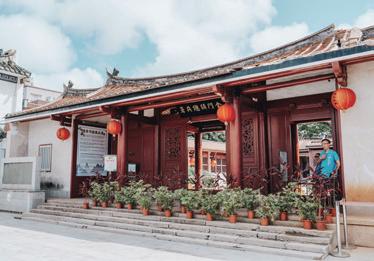


On our way further through the twisting lanes to find Wudao City God Temple, we passed the Kinmen Military Headquarters of the Qing Dynasty. If you’re attending the free evening walking tour of old Houpu (the old name of Jincheng; www.kinmen.travel/en/discover/tour/43; tours are held in Chinese), this sprawling structure is where you’ll begin your excursion. A little further northwest, on Juguang Road, is the Houpu 16 Arts Zone. Quietly shuttered in the morning sun, this spot wakes in the afternoons and evenings as the bars and restaurants draw in a lively crowd.
City God (or Chenghuang) temples are typically found in places that were historically significant loci of power, and they tend to have busy interiors staffed with all the celestial bureaucrats that a community needs to oil the workings of daily life. Jincheng’s Wudao City God Temple is no exception, but it’s the temple’s annual festivities that have earned it a mention in Taiwan’s list of the Top 100 Religious Scenes (taiwangods.moi.gov. tw). The Chenghuang Festival in Kinmen kicks off on the 26th day of the third lunar month with cash offerings from parents seeking protection for their children. Over the following days, donations are sought, neighboring gods are formally invited, and children rehearse their parts in preparation for the grand procession on the 12th day of the fourth lunar month. The parade files around the historic town gates and is famed for its photogenic performances, such as the “centipede troupe,” in which dozens of youngsters – dressed as characters from Chinese legend and lore – are borne aloft on wooden carts.
Wu Jiang Academy was the penultimate stop of our self-led walking tour, before heading to Mofan Street for some shopping. As the name suggests, it was built as an educational facility for the people of Jincheng. The interior’s simple decorations evince studious solemnity – an atmosphere upheld by the statue of Song dynasty scholar-official Zhu Xi gazing beatifically over rows of desks and plaques attesting to local scholars who got into the world’s top universities.





If you’re looking for souvenirs from your Kinmen journey, you’ll want to head over to Mofan Street The two-story arcade buildings along this street were built by a consortium of local business owners in 1924, and feature broad brickwork arches fronting a covered walkway of the style popular in Southeast Asian colonial architecture. Here, behind the plant-fronted columns, you’ll find vendors selling all the region’s top specialties.
For easy-to-transport, snackable souvenirs, you can’t do much better than Kinmen’s tribute candy. Made by combining ground peanuts and maltose, the bite-sized candies have a light sweetness and a crumbly texture similar to a peanutty shortbread. Tianyi Tribute Candy – located towards the north end of Mofan Street – sells several variations on the theme, and visitors can sample the wares before choosing their preferred sweets. Those without such a sweet tooth can peruse the store’s other offerings, such as flavorful Kinmen-grown peanuts or kaoliang-infused beef jerky.
Situated directly opposite Tianyi Tribute Candy, Chuen Shin Kaoliang
Handmade Cake is famed for producing a Taiwan foodie souvenir staple –egg rolls. These flaky, cylindrical treats are generally made using eggs, wheat flour, and sugar, but this store has replaced some of the regular flour with sorghum flour (sorghum being the grass from which Kinmen’s famous kaoliang is made). Packs of various flavors – coffee, matcha, strawberry, and more – can be purchased to take home, but just be aware that these are not the sturdiest of confections and will need to be carefully packed in your hand luggage. While you’re there, be sure to treat yourself to the store’s most popular item, a jumbo egg roll filled with kaoliang ice cream. A light note of the notoriously strong liquor is detectable, balanced out by the sweetness of the egg roll it’s encased within.
Finally, no discussion of Kinmen’s souvenirs would be complete without mentioning Jin Yong Li Steel Knives. The company embodies a Kinmen twist on the adage “when life gives you lemons, make lemonade” – that is, when history gives you a surplus of spent artillery shells, make great big knives. I’ll concede that this doesn’t have the same charmingly upbeat sentiment of the original saying, but it’s certainly an ingenious way of repurposing the hundreds of thousands of artillery rounds that fell on the island. (For context, during the August 23 Artillery Bombardment in 1958, and in the six weeks that followed, 470,000 or so shells were thought to have fallen on Kinmen.) The company operates two premises in the town center. In the modern, brightly lit store on Mofan Street, display cases glint with everything from pocket knives to massive cleavers, while in the original premises – just a short distance from the Chastity Arch for Qiu Liang-gong’s Mother – you can see rows of shell casings lined up and waiting to begin their new lives as high-end kitchenware.

ENGLISH AND CHINESE
Battle of Guningtou | 古寧頭之役
Beishan Broadcasting Wall | 北山播音牆
Beishan Seawall | 北山海堤
Beishan Wind Lion | 北山風獅爺
Chastity Arch for Qiu Liang-gong's Mother | 邱良功母節孝坊
Chenghuang Festival in Kinmen | 浯島城隍文化觀光季
Chuen Shin Kaoliang Handmade Cake | 淳新高梁手工蛋捲
Guandi Temple | 關帝廟
Guningtou (Battle Museum) | 古寧頭 ( 戰史館 )



Jin Yong Li Steel Knives | 金永利鋼刀
Jincheng | 金城
Kinmen Military Headquarters of the Qing Dynasty | 清金門鎮總兵署
Lake Ci | 慈湖
Mofan Street | 模範街
Shuangli Lake | 雙鯉湖
Shuitou (Pier) | 水頭 ( 碼頭 )
Shuiwei Pagoda | 水尾塔
Tianyi Tribute Candy | 天一貢糖
Guningtou Electromobile Tour Service Center | 古寧頭電瓶車旅遊服務中心
Houpu 16 Arts Zone | 後浦 16 藝文特區
Huang Huihuang Mansion | 黃輝煌洋樓
Wu Jiang Academy | 浯江書院
Wudao City God Temple | 浯島城隍廟
yanglou | 洋樓


The smaller of Kinmen County’s two main islands, Little Kinmen (or Lieyu) is a sleepy backwater unlikely to be high up on most people’s Taiwan travel itineraries. But do not write it off! Read on to learn about some of the enriching experiences that await visitors to this frontier chunk of land.
Home to around 13,000 people and a whole lot of cows, Little Kinmen is mostly known for its “wind chicken” guardian deities and melt-in-the-mouth taro. Previously, anyone planning to visit would have needed to catch a ferry from the main island, but the 5km-long Kinmen Bridge was officially opened in 2022, making it easier to pop over and explore at your own pace. And there’s certainly plenty to explore. Think subterranean tunnel networks, picturesquely aged villages, heritage enterprises, and refreshing local snacks – more than enough to merit allocating a day of your Kinmen adventure to this unique place.



Barely 500m from the western end of Kinmen Bridge, the Tie Han Fort and Yongshi Fort duo are among the first structures you’ll come across when you arrive on Little Kinmen. Although listed separately on Google Maps, these forts are interconnected and their one-way foot flow means they can only be accessed via the Yongshi Fort side – not far from a popular restaurant serving all manner of taro-based treats. Admission is NT$30 for an adult – tickets can be bought at the entrance.
Entering, it’s immediately apparent why the one-way system has been implemented. A walkway – barely wide enough for two burly soldiers to squeeze past each other – sinks down into the depths of the earth. As the tunnel begins to level out, it also widens, and the remainder of it is occupied by an exhibition dedicated to the horrors of landmines. When amphibious landings were a real threat, minefields littered Kinmen’s coastline, with over 100,000 individual mines placed as a deterrent. Bilingual exhibits detail the painstaking, treacherous, and ultimately successful demining efforts.
To leave the tunnel, you have to walk through a simulated minefield. Gravel crunches underfoot and motion sensors trigger an onslaught of flashing lights and the sound of explosions. It’s unpleasant, but thankfully, it’s the closest any visitor to present-day Kinmen will get to experiencing a landmine.

As mentioned earlier, before Kinmen Bridge opened the only way to get to Little Kinmen was by ferry. Once every 30min the boat from Shuitou Pier would dock, disgorging its cargo of scooters, cars, and foot passengers at Jiugong Pier. It makes sense then, that as the jumping-off point for exploring Little Kinmen, the island’s main visitor center would be situated here.
From the pier, a short wander along a waterside path will take you to the Jiugong Tunnels and Lieyu Visitor Center. The entrance is marked with another of Kinmen’s many repurposed military facilities – in this instance, a field hospital enjoying a second life as a toilet block. As with the better-known Zhaishan Tunnel on Kinmen’s main island, the subterranean network at Jiugong was built by Chiang Kai-shek’s army in the wake of the 823 Artillery Bombardment in 1958 – a significant military event that kicked off the Second Taiwan Strait Crisis. Construction began in 1963, with soldiers laboring to carve interlinking boat and pedestrian tunnels out of the granite bedrock using little more than jackhammers and brawn.
The tunnels were designed to facilitate the safe delivery of food and military provisions to the island, and could also be pressed into use as an overflow ward for the hospital if its small complement of beds was full. These days, the pedestrian






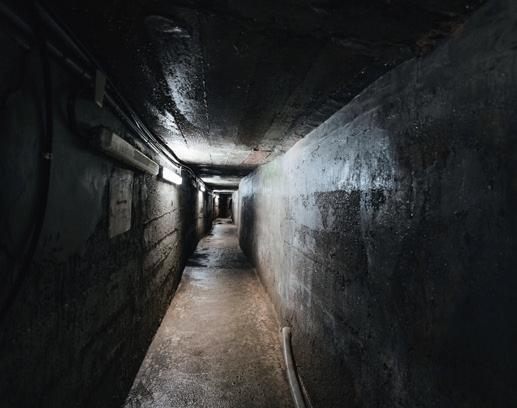
tunnels are filled with illuminated exhibits introducing the history of the site as well as some of the cultural, ecological, and military scenes from around the island, while the main boat tunnel has been kitted out with lights and a walkway allowing for easy exploration. There are multiple ingress and egress points, and if time permits, you could exit via the Luocuo Village side and stroll back to the pier along the coastal boulevard.


Shaxi Fort sits on a protuberance jutting out into the waters at the westernmost limit of Little Kinmen. Built in the 1970s by the ROC Army’s Tiger Battalion, descending below ground here is a more claustrophobic experience than at any of the other tunnels mentioned previously. The 140m-long main tunnel is tolerable – if narrow – but the shoulder-width offshoots fanning out to low-ceilinged bunkers are decidedly tight. (As with the Yongshi and Tie Han forts, an NT$30 entry fee is charged.)
Those who brave the squeeze will be greeted by a blue ceramic figurine of what at first appears to be a troglodytic wind lion god (see page 30). A closer look, however, reveals it to be not a lion at all, but a fierce tiger. This is Master Tiger, the tutelary deity of the Tiger Battalion. A puddle of NT$10 coins is spilled out in front of the figure – tokens from visitors hoping for peace and protection. Deeper in, concrete gun emplacements frame sections of the scenery beyond, the sound of the water slapping against the rocks below loud enough to drown out any footsteps in the passageways behind you.
Above ground, a raised wooden walkway snakes over the rocky promontory, terminating at a viewing pavilion facing China. In the bizarrely near distance, Xiamen’s skyscrapers rise from the waters, easily seen with the naked eye, and on the day of our visit towering cumulonimbus clouds massed over the land, mirroring the buildings’ skyward reach. Binoculars bring the port city even closer, and if you know where to look you might even spot Xiamen’s propaganda wall upon which the slogan “One Country, Two Systems, A United China” is picked out in huge red Chinese characters – a foil to a similar Taiwanese installation on minuscule Dadan Island (southwest of Lieyu).
“Luxury Drink” proclaims the text on bottles of soda from Huanan Soda Factory, located in tiny Donglin Village. Today, the claim that these thirst-quenching sarsaparillaflavored beverages served in repurposed rice wine bottles are a luxury seems a little bold, but when the factory opened in the late 1960s, one bottle cost the equivalent of three whole cabbages, putting them beyond the reach of most locals. Consequently, the majority of the factory’s customers were soldiers burning through salaries paid in the form of “for use in Kinmen only” banknotes. The factory did a roaring trade, being the only soda producer on islands that housed troops numbering 100,000-odd, but eventually, cheap imported drinks and increasingly salinized groundwater drove it out of business.
Abandoned for over 40 years, the factory reopened in 2020 as a hybrid factory, museum, and café. Currently, visitors can choose from five flavors: sarsaparilla, Kaoliang liquor, lemon, smoked plum, and mulberry – the last four of which are made using local ingredients and without artificial flavorings. And for visitors who want a unique – if perishable – souvenir from their trip, there is the option to enjoy a DIY bottling activity. The bottles used for this are the very same recycled (and sterilized) rice wine bottles that were used back in the ’60s, and for extra authenticity, you get to seal shut your hand-mixed soda with one of the dwindling stock of bottle caps that were left when the factory originally shut its doors.






Yuanxing Store
Just as in Donglin, the fortunes of neighboring Xifang have ebbed and flowed with the number of soldiers stationed in Kinmen. Today, only traces of its former glory years can be found in the fading hand-painted store signs. Jianianhua Ice Shop is one of a clutch of businesses that have moved in to enliven the sleepy settlement.
jarring to a Western palate, but it’s certainly something you’re unlikely to find anywhere else in the world.

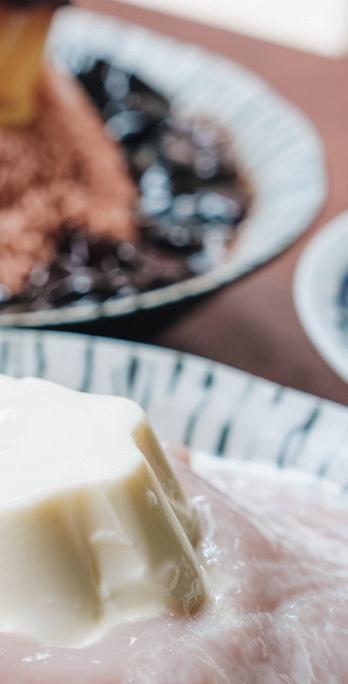
The menu predominantly features traditional flavors such as taro or peanut – both of which grow well in Kinmen’s sandy soil – alongside a few more contemporary offerings like milk tea. The firm favorite amongst our Travel in Taiwan team was the honey-taro ice, which comes slathered in a layer of sweetened taro paste along with a scoop of red beans and chewy sweet potato balls and topped with a milk pudding. We also tried a Little Kinmen specialty, “bucket pastries in milk.” “Bucket pastries” are small pastries made with sesame and green onion; the somewhat unappealing name is thought to have come about because they were previously stored in buckets to preserve freshness. The combination of sweet and salty might come as
HUANAN SODA FACTORY ( 華南汽水廠 )
0985-117-107
No. 81-2, Donglin, Lieyu Township, Kinmen County ( 金門縣烈嶼鄉東林 81-2 號 )
JIANIANHUA ICE SHOP ( 嘉年華冰菓室 )
(082) 363-126
No. 19, Xifang Community, Lieyu Township, Kinmen County ( 金門縣烈嶼鄉西方社區 19 號 )
YUANXING STORE ( 源興興商行 ) (082) 362-255
No. 41, Qingqi Village, Lieyu Township, Kinmen County ( 金門縣烈嶼鄉青岐村 41 號 )
Although Little Kinmen boasts a grand total of two 7-Elevens and one FamilyMart, every single small community has its own mom-andpop convenience store selling basic necessities, and a trinket or two for stray tourists. In the island’s westernmost settlement of Qingqi, that role is filled by Yuanxing Store . Located in a residential building set back from the road, walking inside it feels a little like stepping back in time. A TV plays Taiwanese historical soap operas, and shelves are stacked with lightly dusted boxes of Kaoliang. The only incongruity is a table of handmade cakes and cookies, made – as the proud store owner told us – by her daughter, who has a café “under the tall tree over there.” Sure enough, a short amble through the houses brought us to the old village chief’s office, now a café – the perfect spot to dodge the heat as you figure out your next adventure.
ENGLISH AND CHINESE "bucket pastries in milk" | 桶餅牛奶
Dadan Island | 大膽島
Donglin | 東林 Jiugong Pier | 九宮碼頭
Jiugong Tunnels | 九宮坑道
Kinmen Bridge | 金門大橋
Lieyu (Visitor Center) | 烈嶼 ( 遊客中心 )
Little Kinmen | 小金門
Luocuo | 羅厝
Qingqi | 青岐
Shaxi Fort | 沙溪堡
Shuitou Pier | 水頭碼頭
Tie Han Fort | 鐵漢堡

Xifang | 西方 Yongshi Fort (Landmine Exhibition) | 勇士堡 ( 地雷主題館 )
Zhaishan Tunnel | 翟山坑道
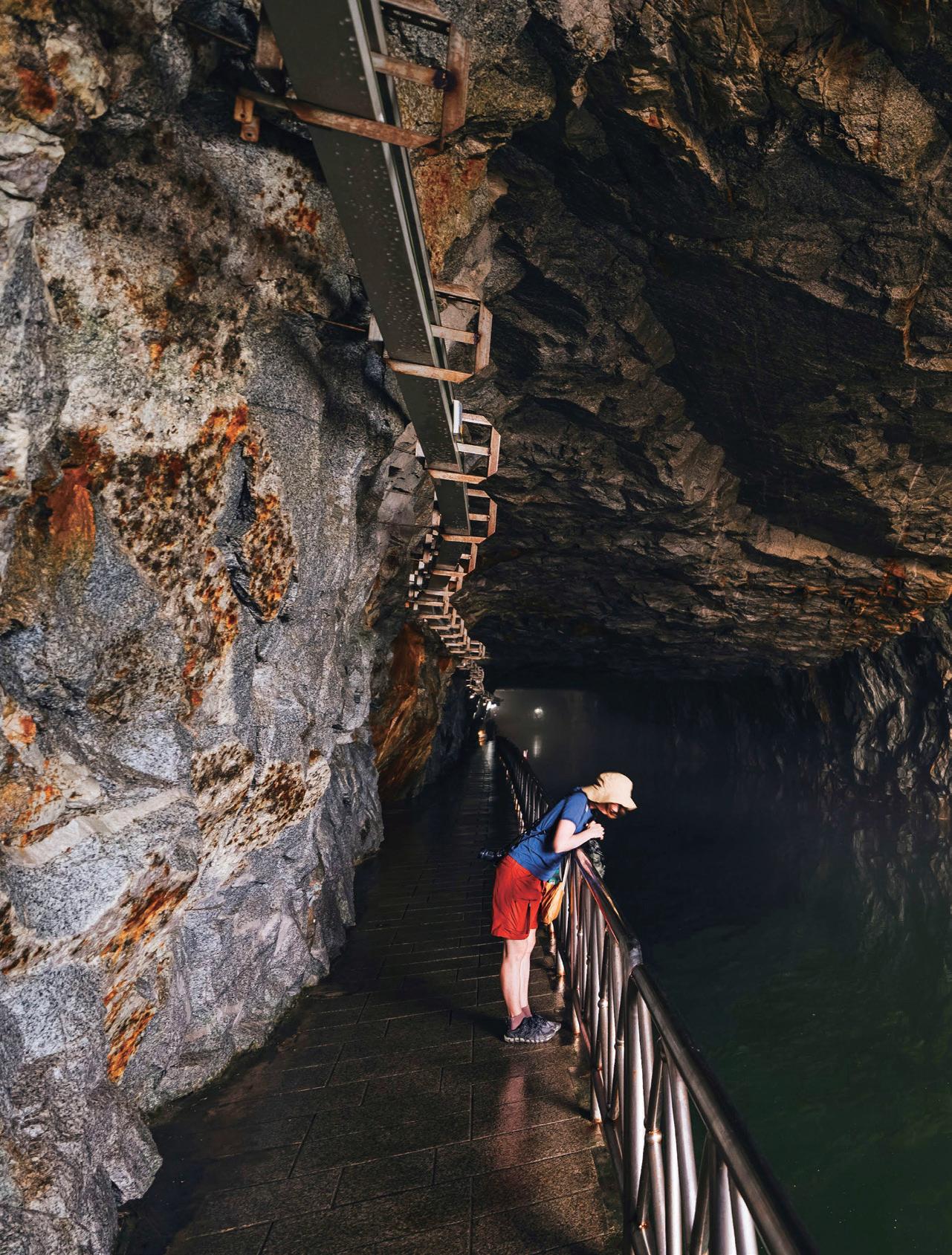
Kinmen’s stimulating variation in tourism attractions invites theme touring, which has become a popular travel style, especially among visitors zooming through the islands by motor scooter. Here we present three of the most popular themes, focused on the islands’ exclusive troves of military tunnels, Wind Lion God statues, and wildlife – specifically, its migratory and resident birds and its Eurasian otters. These four foci will, it might be said, deliver you to Kinmen’s underground, surface, sky, and water worlds. There’s enough choice in each category that you can pursue a single theme over multiple days. Or choose a new theme for each day of your stay.
Forcing several metaphors together, over the Republic of China’s (ROC’s) years of tension with the People’s Republic of China (PRC) the granite-built islands of Kinmen have served as unsinkable bastions housing a battalion of military fortifications dug right into the deep rock. Many of these have now been decommissioned, with a wonder-inspiring array opened for tourist visits, especially tunnels. The most famous and most visited is the giant’slair-sized Zhaishan Tunnel. Other key sites are the Jiugong Tunnel (more on this in our main Kinmen article), Jincheng Civil Defense Tunnel (entertainingly, its entrance is on the second floor of Jincheng town’s bus station; built to house government, bank, etc. operations).
The Zhaishan Tunnel is the most remarkable of the many Cold War facilities now open for public visit. The colossal U-shaped cavern was hewn almost solely by hand from solid granite over five years in the 1960s, within a seaside breakerbashed hill-and-cliff formation. It was used as a safe harbor for supply boats making the run to and from Taiwan proper, with a capacity of 42. There are two portals on the crashing-sea side, to ensure continuous ingress/egress if under attack. A good information display is set up outside the visitor entrance, and you’ll also enjoy the outdoor exhibit of anti-aircraft guns, supply boats, and other decommissioned equipment. Note that a pathway to the left of the entrance leads you down to coastal views of the water-level portals.
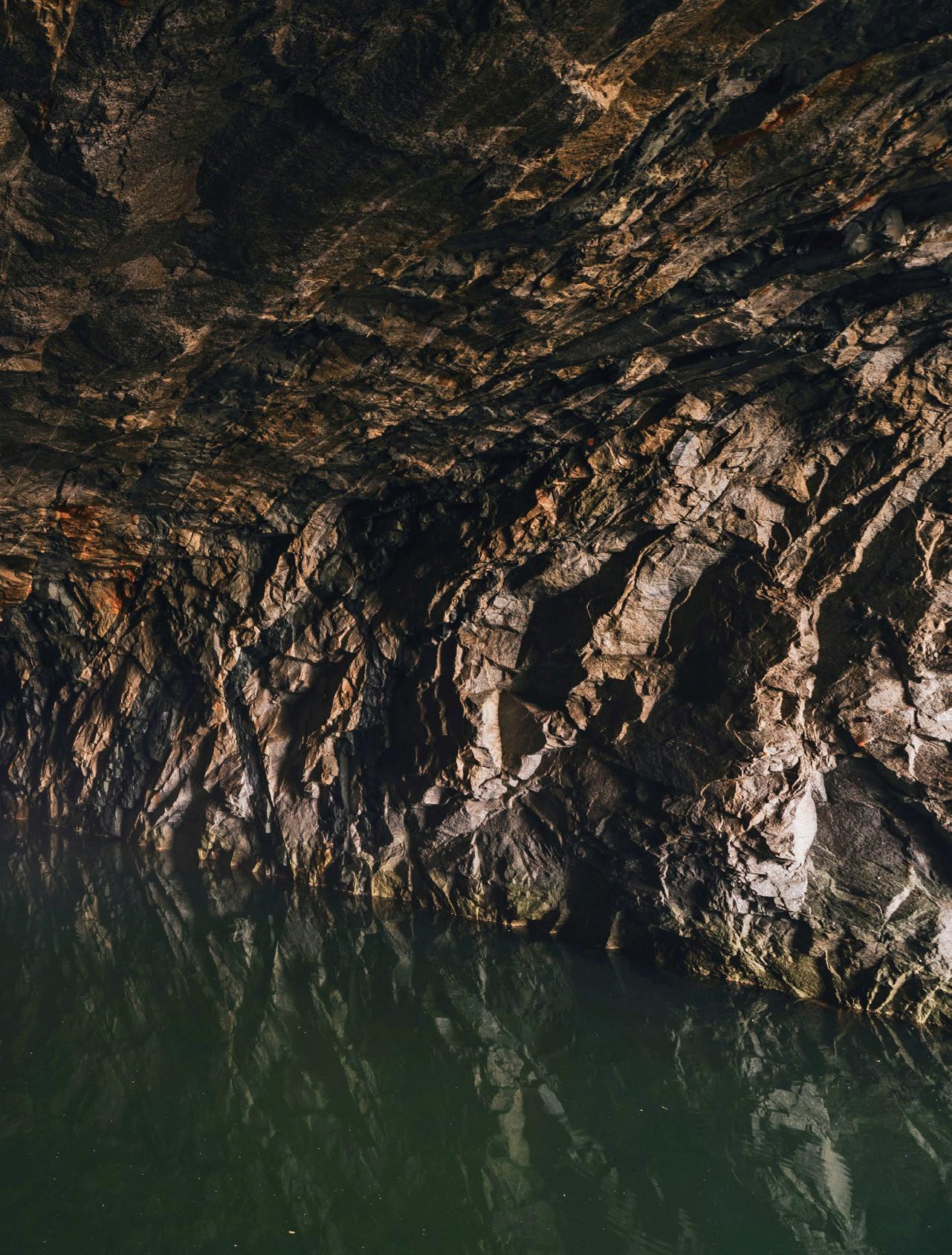
Turns out that the acoustics within the Zhaishan Tunnel are pitch-perfect for live music, inspiring the use of this natural granite-walled concert hall for the creatively original Kinmen Tunnel Music Festival since 2019. Staged each autumn (October 12-13 this year), both Chinese and Western classical music are on the program, performed by premier talent invited from around Taiwan.

“Wind Lions” are found in picturesque spots all around Kinmen, and hunting down as many as possible of these unusual Wind Lion God statues has become a favorite touring theme with DIY travelers. Pick up one of Kinmen’s special free Wind Lion tour maps at any local tourist information center. A bonus to these quests is that they take you to places away from the main tourist routes.
There are about 80 larger Wind Lion statues in total, of varied shapes and sizes, with a hundredplus smaller editions on rooftops. They’re placed in strategic exposed spots to deflect the winds that swoop over the flat islands in winter, protecting homes and farm fields. Centuries ago the prosperity of these (then) trading islands brought deforestation (1200s through 1600s), with land cleared for farms and salt pans. Popular lore, however, says the denudation came from cutting trees to build the massive fleet of Koxinga, the 17th-century Ming Dynasty loyalist who contested the China-invading Manchu Qing, but faced with defeat fled to Taiwan, expelling the colonial Dutch from the island.
In Chinese folklore, the auspicious lion can also both ward off evil and attract good fortune, and thus over time Kinmen folk have also turned to the Wind Lion for safeguarding against such other undesirables as pests, flooding, and even danger at road intersections notorious for accidents.
The oldest statues are believed to date from the late 1600s. Most of the lions stand upright; others crouch, are seated, set to pounce, etc. The majority are unpainted, but many are brightly rendered in striking colors. Note how all have long, wide mouths – enabling effective swallowing of winds. Males can be distinguished by the large, exaggerated “anatomically correct” bottle gourd between their legs; females carry a pom-pom or ribbon. Old-time local belief is that touching the gourd will help ensure male offspring for expectant mothers. You may see that a statue is draped in a cape; this is generally done in gratitude by individuals for requests granted.

When you think of big islands floating in Pacific waters just off the China coast in a subtropical zone, the idea of birds migrating in great numbers seems natural. But the idea of these islands as home to “flocks” of cute furry otters strikes many as odd, particularly travelers from northern climes. Yet ’tis true!
Kinmen’s particular set of 20 th -century circumstances meant no development of heavy industry and little development of light. The beneficial result for today’s traveling visitors is exceptional ecotourism opportunities.
Let’s get to the otters first because no doubt that is what’s got your interest most piqued. These are Eurasian otters, which are endangered. Once spread widely in freshwater habitats throughout Europe and Asia, habitat fragmentation has left Kinmen’s otters part of one of three separatezone subgroups. This isolation has led to the development of distinct genetic and physiological traits. Kinmen’s colony is the most stable and has the highest population density along the East Asia coastal region. Over 100 otters have been recorded here; they’ve only been recorded in six other locations along the China coast, clustered in the Yangtze and Pearl river estuaries.
The county government has helpfully created a distribution map showing where otter-trackers can find them: kinmen.travel/en/discover/nature. A quick look reveals how the otters have adapted well to Kinmen’s manmade reservoirs. Note that the best spotting opportunities are in the evening.
Now, over to the birds – 300 species have been recorded, compared to 500 for the ROC in total. The majority are migratory, and many of these overwinter in Kinmen. Two avians vying for Kinmen brand-icon status are the hoopoe and bluetailed bee eater; the former is orange-ish with zebrastripe wings, and the latter is a bright painter’s palette. Recommended birding destinations are the Tianpu Reservoir for bee eaters, Shuangli Wetlands for kingfishers, waterfowl, and birds of prey, Lake Lingshui, Lake Xi, and the Tiandun Sea Wall for oriental skylarks, oystercatchers, terns, and collared pratincoles, and Lake Ci for cormorants.
ENGLISH AND CHINESE
Jincheng Civil Defense Tunnel | 金城民防坑道
Kinmen Tunnel Music Festival | 金門坑道音樂節
Koxinga | 國姓爺
Lake Ci | 慈湖
Lake Lingshui | 陵水湖
Lake Xi | 西湖
Shuangli Wetlands | 雙鯉濕地
Tiandun Sea Wall | 田墩海堤
Tianpu Reservoir | 田埔水庫
Wind Lion (God) | 風獅爺
Zhaishan Tunnel | 翟山坑道


Tainan City is the garden where Taiwan’s modern era took root. This was the island’s first urban settlement, established by the colonizing Dutch in 1624, who were driven out decades later. Glorious Tainan thereafter served as Taiwan’s Chinese imperial capital for over two centuries. Economic activity shifted to the north in the 20 th century, leaving priceless architectural heritage intact, and recent decades have brought an economic and cultural renaissance bloom.

The place name “Tainan” translates as “Tai(wan) South.” It has long been the south’s cultural heart, while the powerhouse port city of Kaohsiung, a short drive further down-coast, is the economic/industrial heart. And yes, “Taipei,” Taiwan’s capital, is “Tai(wan) North.”
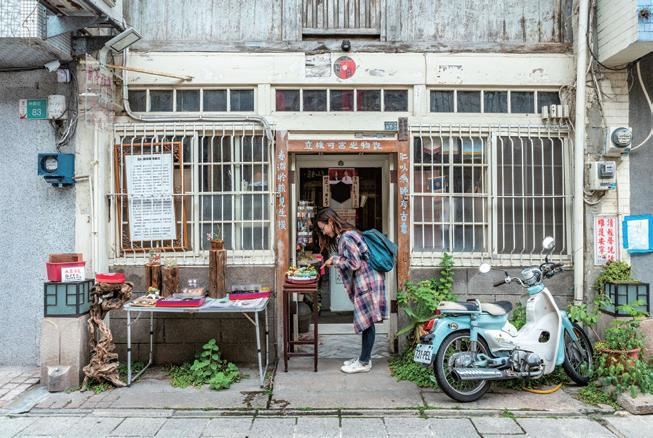
A most stimulating place to embark on a day’s walking tour of the old Tainan city core is cozy Shennong Street, stacked with long and narrow historic two-story shophouse buildings hosting cultural-creative shops (recommended for souvenir hunting, collectively brimful with handmade creations), artist studios, as well as quaint compact cafés, teahouses, bars, and eateries – plus a smattering of homestay operations. Adding to the old-world ambience and the tight-knit community feel are two city-designated historic sites, Jinhua Temple and Yaowang Temple. Many of the shophouse structures date to the late Qing Dynasty (latter 1800s) and Japanese colonial (18951945) periods.
Shift down to your slowest walking gear to allow time for admiration of the eclectic yesteryear façades, each a distinguishing artistic expression; many have been further prinked and personalized to announce the new 21st-century ventures now moved in. The artery, which is just a few hundred meters long, is especially busy and alluring after the sun sets when retro-style lamps introduce an ethereal night-time glow that evokes the settings travelers rejoice in when ambling the old quarters of Nice, Bordeaux, and other romance-tale European destinations.
Shennong Street intersects with a major north-south thoroughfare, Hai’an Road, on its east end. “Hai’an” translates as “sea tranquility,” a clue to the fact that the coastline once ran alongside. The land under Shennong Street stretched out into the water, pier-like, flanked by short transport canals. Goods were brought in by boat through the canalfacing backs of the shophouses. Shops were in the front section, facing the street, storage was above on the second floor, and family quarters were toward the rear. Fore and aft edifice sections were often divided by a sky well, a courtyard area allowing in sunlight. Looking at Google Maps, you can see how silting has pushed the Taiwan Strait kilometers to the west; the nearby Anping Canal is a vestige of the long-vanished harbor area.


Just to the east of Shennong Street is an aromatic and forever-abuzz timeless neighborhood where you can dive headlong into traditional local Tainan living as pursued generation after generation back into imperial times. Browse heritage markets and feast on some of the pantheon of snacking classics the city has gifted to the global gourmand table. The enclave is fixed on north-south Guohua Street (Section 3), a narrow old-ways market street teeming with family-run operations that spill right out onto the street. Guohua parallels the aforementioned Hai’an Street, one compact block to its east.
Cross Hai’an from Shennong Street and you enter the excitingly cacophonous Shuixian Temple Market , among the city’s oldest. The covered forest of stalls within surrounds the venerable Shuixian Temple, established in 1703 – remember, this spot was once at the harborfront –with a cadre of deities especially dear to traders, seafarers, and fisherfolk resident within, specialist protectors against waterrelated disaster. Tainan City tourism authorities have referred to this market as “Tainan’s Kitchen,” high praise indeed given the fact this city is home to a number of Taiwan’s most-cherished traditional markets.
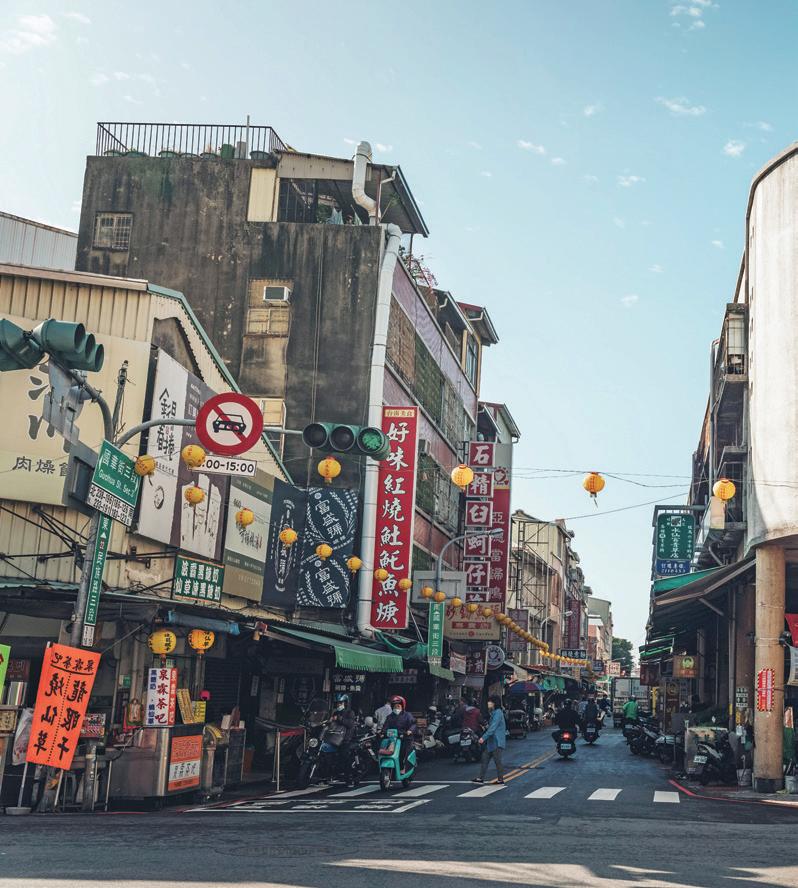
Among the most celebrated of the many long-in-place family-run operations in the market is the Bao Lai Xiang bakery. It’s been making palates happy for over seven decades now, a seller of peng cakes and other old-time baked yummies Tainan is known for. Peng cakes are puffed-up pastries with a very thin outer layer that is crunchy and crumbly and, within, a “hollow” inside the rounded top and caramelized brown sugar at the bottom. The Tainan region is a flourishing sugarcane cultivation area, its heyday being the late Qing imperial era and Japanese period of rule.

Another market with a legitimate claim to being “Tainan’s Kitchen” is close nearby – Yongle Market, at the Guohua Street/Minzu Road corner. Like our first-visited market, this labyrinth stuffed with a hundred-plus operators is a covered operation. While sophisticated Taipei is known for its legions of more upscale restaurants, Tainan is known around Taiwan as the island’s creative kitchen for xiaochi or “little eats”– i.e., fresh-made snacking delicacies. Though even busier with tourists than Shuixian Temple Market, this remains a true food bazaar serving locals – you’ll even see regulars wading slowly through the crowded aisles on their scooters, purchases dangling from handlebars.


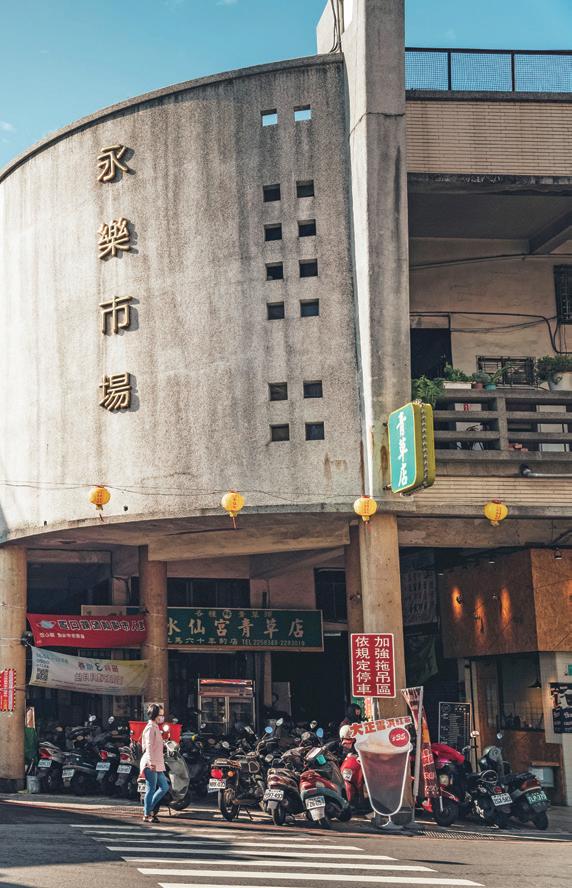
Directly across Guohua Street from Yongle Market at the Guohua/Minzu intersection is one of Tainan’s best-known purveyors of Taiwan-style spring rolls, Jinde Spring Rolls. The founder ran a stall nearby selling cold drinks in the 1950s and started making spring rolls in 1954, seeing the steady demand especially during the springtime Tomb Sweeping Festival. The move to this location was made in 1966. Jinde’s soft wrap-skins are lightly pan-fried; the filling consists of cabbage, shrimp, pork, dried tofu, egg, beans, garlic, coriander, peanut powder, and sugar.
Just a couple doors down along Guohua Street is Fu Sheng Hao Rice Pudding , a household name in Tainan, established in 1947. Taiwan’s iconic savory rice pudding is known as wagui, using the Taiwanese pronunciation, literally “bowl cake.” Inside a bowl of steamed sticky rice paste are tasty “hidden treasures.” Inside Fu Sheng Hao’s fresh-crafted version, your key discoveries will be shrimp and ground pork. The mixing in of soy sauce gives it a color darker than found elsewhere.

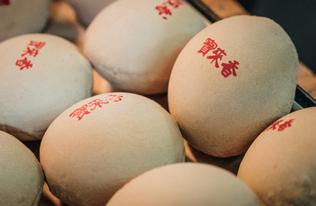
Sharp-eyed readers will have noticed that shrimp featured in the signature delicacies prepared at the above two entries. Seafood is, indeed, a major player on the local snack stage; Tainan was the island’s major port through Taiwan’s imperial period, and fishing/aquaculture remain two important regional industries. A block-and-a-bit north along Guohua Street, in a quieter commercial/residential zone, is Qiu Family Squid Rice Noodles . The signature dish here is simple yet both delicious and filling – firm rice noodles in a light broth served with chunks of the freshest tender (no rubberiness) neritic squid and celery pieces.
{To get to the Anping Old Street area, take the Tainan Sightseeing Bus (www. tainansightseeing.com.tw) from the Shennong Street bus stop on Hai’an Road; get off at Anping Fisherman’s Wharf bus stop; walk north to Anping Road, then turn left.}
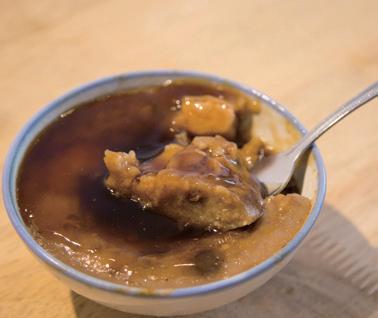
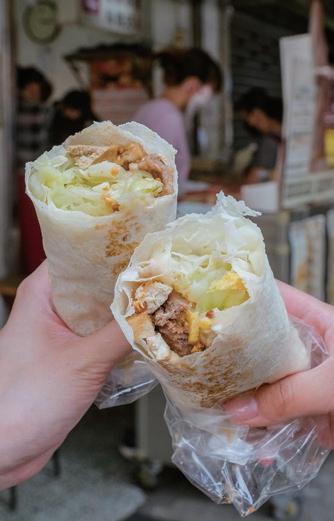

The Anping Old Street/Anping Fort area, perhaps Tainan’s most popular tourist draw, is due west of the Shennong Street/Guohua Street area, roughly a kilometer distant. Look down on it from the sky, i.e. using Google Maps Satellite View, and you’ll see expanses of water to its west, north, and south – the north swath consisting largely of aquaculture farms and mangrove wetlands.
When the Dutch launched Tainan they built a bastion, Fort Zeelandia, at the tip of a long spit of land that stretched into open water. This and several aligned silt islands running northward formed the outer edge of what was called the Inner Sea. Silting has now mostly swallowed this up, but vestiges remain.
The Anping Old Street neighborhood is the site of the first Dutch settlement, which formed beside the fort. At its heart is narrow Yanping Old Street, dubbed “Taiwan’s 1st Street” – the first-ever commercial street to form. The quarter’s brick- and stone-paved lanes are thronged with tourist-focused eateries and sellers of handicrafts, many handmade.
While on your walkabout, keep an eye out for the priceless Anping collection of heritage “one-arm houses.” In times past, because of crowded conditions one arm of the traditional Chinese three-sided courtyard residences, called sanheyuan , was left off in homes here, creating a distinctive “L” shape. The family/altar room was in the main section and a bedroom and kitchen were in the arm.


When one’s tummy invariably sets to rumbling for attention, here are a couple of Anping foodie options: Deyi Shrimp Biscuits creates big, thick, crispy shrimp biscuits in a diversity of flavors; this is a retail enterprise specializing in souvenir purchases, though you can also eat hot and fresh on the spot. Opened in 1971, the operator family proudly uses only natural ingredients, eschewing preservatives and artificial additives. Shrimp biscuits are a fried treat, and great care is taken here to make munchies free of the oiliness often encountered elsewhere with fresh-made versions (it also now has baked editions). They’re crafted with shrimp paste, egg white, corn flour, sugar, and seasonings. Only local wild shrimp from the Anping area are used, no farmed products. Beyond original flavor, other options include spicy, black pepper, onion, laver, and more recently added Thai- and Mexican-style.
No, Taiwan’s famed beef noodles and delicious Tainan-style beef soup are not the same thing! Though the simplest of dishes, this beef soup packs tremendous flavor, and Anping’s A-Cai Beef Soup is one of the city’s go-to makers. Thin strips of the freshest raw beef produced in Tainan (slaughtered the same day) are dropped in steaming-hot beef and ginger broth, the broth doing the cooking on the spot. The meat is so melt-in-your-mouth tender and flavorful that no seasonings are required.
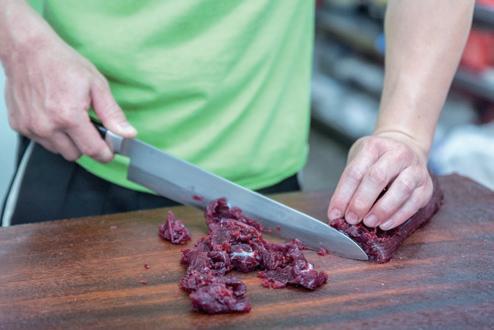

The site of Fort Zeelandia’s ruins is today called Anping Fort. Little of the fort remains – a good deal of the materials were used by the Chinese military to construct another popular and largely intact attraction nearby, the Eternal Golden Castle (another fort), in the 1870s. Your experience will be richly rewarding nonetheless, for there is good and ample English signage explaining the ruins and on-site digs, plus a small museum in a hilltop maritime-customs building built by the Japanese in the 1940s. Be sure to tackle the steep stairs in the maritime-customs tower, delivering you to sweeping views in all directions, including the now far-off coast.
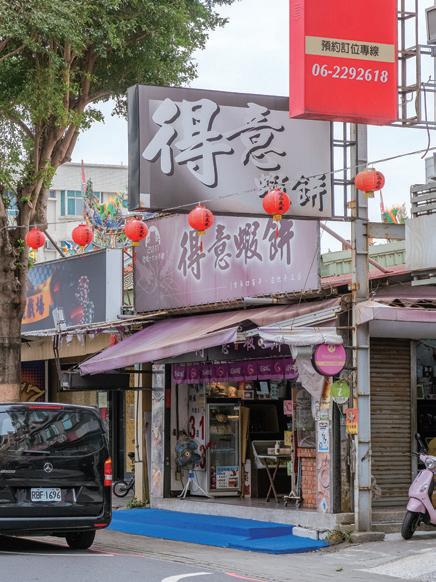
ENGLISH AND CHINESE
A-Cai Beef Soup | 阿財牛肉湯
Anping Canal | 安平運河
Anping Fort | 安平古堡
Anping Old Street | 安平老街
Bao Lai Xiang Cakes | 寶來香椪餅
Deyi Shrimp Biscuits | 得意蝦餅

Fu Sheng Hao Rice Pudding | 富盛號碗粿
Guohua Street | 國華街
Hai'an Road | 海安路
Jinde Spring Rolls | 金得春捲
Jinhua Temple | 金華府
peng cakes 椪餅
Qiu Family Squid Rice Noodles | 邱家小卷米粉
sanheyuan 三合院
Shennong Street | 神農街
Shuixian Temple (Market) | 水仙宮 ( 市場 )
xiaochi | 小吃
Yanping Old Street | 延平老街
Yongle Market | 永樂市場

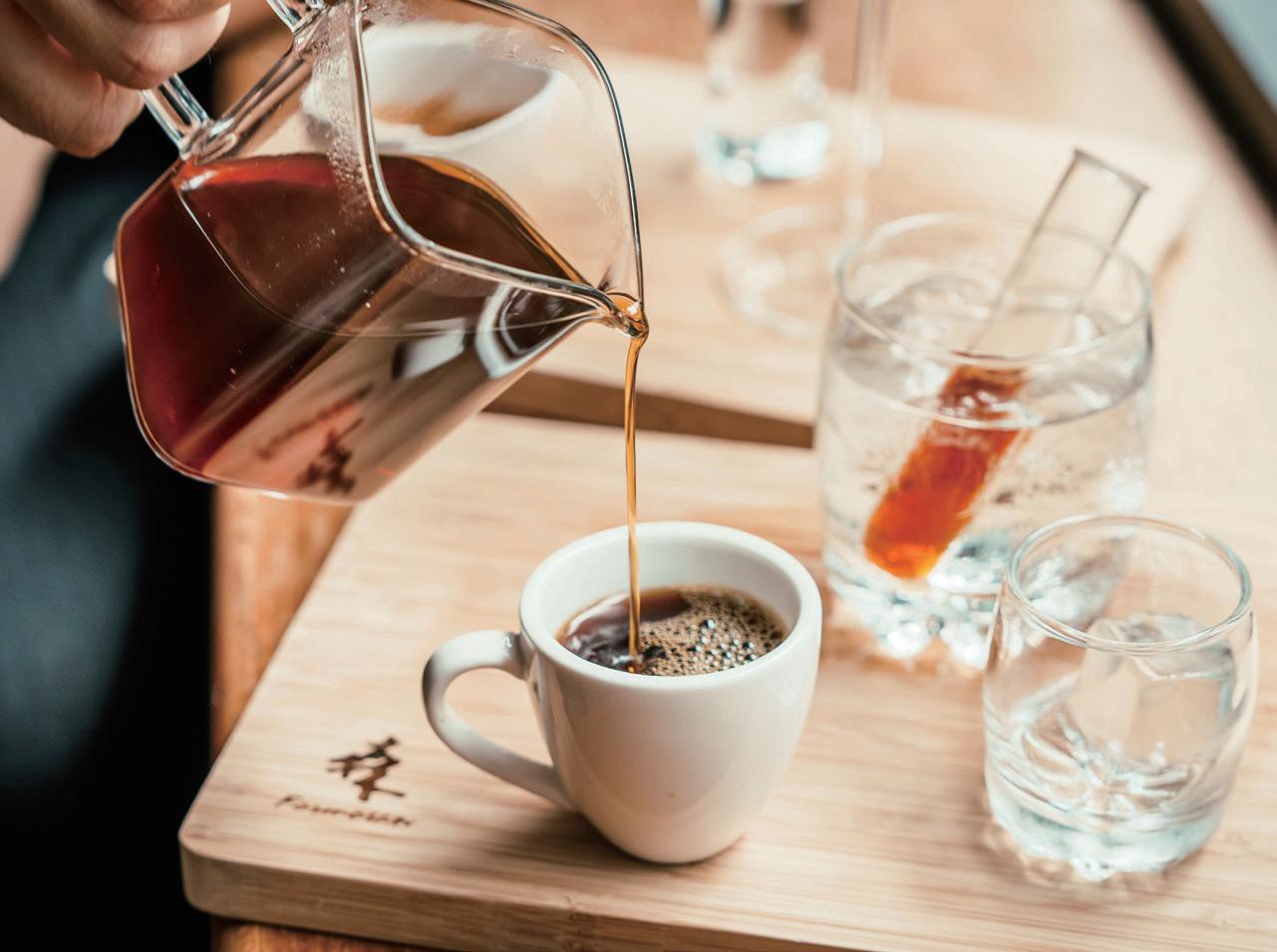
There is no better way to understand Taiwan’s coffee culture than to explore some of its most renowned cafés, from world-champion brewers and baristas to purveyors of Taiwan-origin beans.

Old guidebooks used to call Taiwan a land of tea drinkers, introducing upmarket teahouses, to-go tea shops, and the world’s finest oolong teas. If you preferred coffee, well, good luck. In the past twenty years, though, the popularity of coffee has exploded, completely transforming the way Taiwanese caffeinate themselves. From inexpensive coffee at convenience stores to some of the foremost baristas in the world, student cafés that open at 1pm and close after midnight, and affordable chain operations in every town, Taiwan’s coffee culture has grown to rival the best the world has to offer, and is now an integral part of local life.
In fact, coffee has become so ingrained in Taiwanese culture that affordable drinks are available at over 12,000 convenience store locations. At the higher end, Taiwan has the highest density of licensed coffee cuppers in the world – that is, professionals who observe the taste and aromas of brewed coffee – at around 700 in a population of 23.4 million.


This operation is unique in that it roasts and serves exclusively Taiwanese coffee, focusing on both localism and environmental preservation. Founded in 2011, SanFormosan opened its first café in 2016 and has expanded to several locations since.
The flagship outlet is both bustling and airy, with light pouring in through large windows overlooking Taipei’s leafy Zhongshan North Road. Their commitment to Taiwanese-origin coffee shows in the decor, including a wall of Chinese ideographs, each denoting a different place in Taiwan. The island’s topography and climate are well-suited to growing coffee beans, and coffee farms have proliferated in recent decades.
“There are many places where coffee grows well in Taiwan,” notes Krude Lin of the Coffee Industrial Alliance of Taiwan, which aims to promote Taiwanese coffee both within Taiwan and globally through involvement in the entire coffee-growing supply chain.
“The Alishan area produces some of the best coffee because of the climate. They have the tea industry (experience), so there’s a density there (of people who can be trained). Namaxia District (in Kaohsiung City) and Nantou County also have some great coffees, and Hualien County is big on organic coffee.”
Beans from these areas and more can be found on SanFormosan’s menu, which is just as much a lesson on Taiwan’s geography as a list of products for sale. Their hot single-origin coffees are served in glass carafes, along with a small beaker bathed in ice water, enabling one to marvel at the subtle differences in flavor between a hot and cold brew of the same bean.
“We wanted to introduce the best and freshest products from local farms,” says SanFormosan’s Sylvia Lin. “Most Taiwanese are aware of coffee beans from other countries, but relatively few know that Taiwan also grows coffee.” Each region and farm produces coffee with a distinctive flavor profile, Lin explains. “In fact,

Café
coffee cherries are a kind of fruit. Imported fruit is fine, but it’s more delicious and fragrant when it’s fresh. And different areas and farms will produce fruit with different tastes.”
This uniqueness is further enhanced by the use of different processing methods. How the coffee cherries are cleaned and fermented has a deep, but often underappreciated, impact. Most of SanFormosan’s single-origin coffees, including their Kaohsiung Namaxia and Taitung Taimali, are washed, meaning the flesh of the coffee cherry is stripped away before the mucilage and seed are fermented in water, resulting in a lighter, cleaner flavor. Their Nantou Mt. Chiu-fen-erh is pulped –the pulp removed, but the cherries not fermented in water – and still others are “natural,” that is, dried whole in the sun. Coffees prepared this way tend to have stronger, more fruit-forward notes.
“Each brew is distinct, and clients all have their favorites,” Lin remarks. “It’s hard to say one or the other is ‘the best’.”
Their natural Tainan Dongshan bean might appeal to fans of sour, lighter roasts. Enjoyed hot, it has a bright acidity balanced with notes of honey, with a tealike flavor coming out when iced. Their SanFormosan Signature coffee is darker and nuttier, with cocoa undertones while hot. Served iced, chestnut and brown sugar flavors emerge.
In addition to Taiwanese coffees, SanFormosan offers full meals, desserts, and beans for home brewing. For the desserts, traditional Taiwanese flavors are used in creative ways, including an unexpectedly scrumptious salted egg ice cream, and French toast with bubble tea-style tapioca balls and Tieguanyin tea milk syrup. Unique coffee drinks include beans steamed in Kaoliang liquor from the Matsu Islands and infused with rose or osmanthus florals.
French toast with tapioca balls
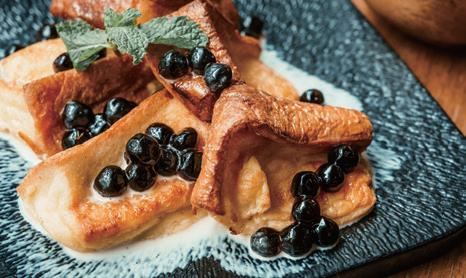
SANFORMOSAN CAFÉ / ZHONGSHAN FLAGSHIP STORE ( 森高砂咖啡館 / 中山旗艦店 ) (02) 2568-1517
No. 133, Sec. 1, Zhongshan N. Rd., Zhongshan District, Taipei City ( 台北市中山區中山北路 1 段 133 號 ) 11am~8pm (until 9pm on Fri. and Sat.) sancoffee.shop (Chinese) www.facebook.com/SanCoffeeShop
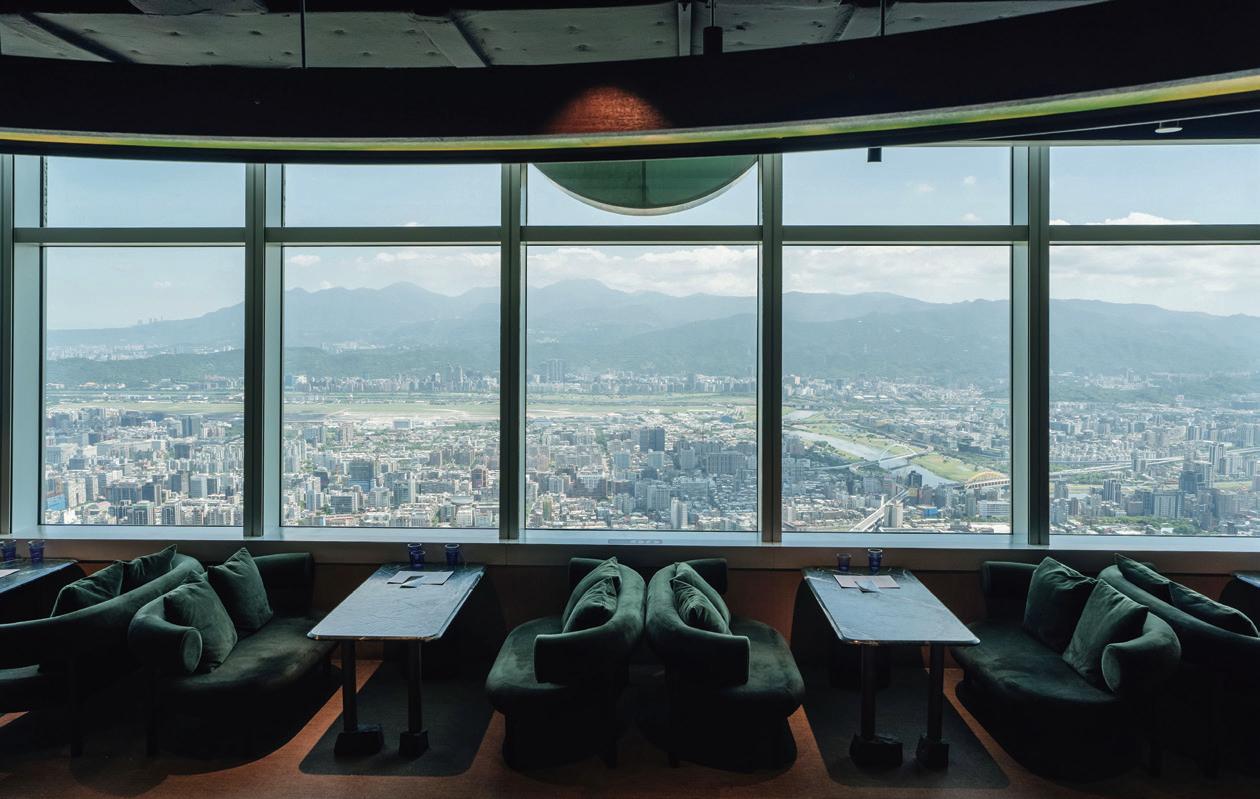
Walking into the Simple Kaffa Sola outlet is a little like flying. Located on the 88 th floor of the Taipei 101 skyscraper, visitors are greeted with a panorama of mountains and sky, and the view only gets better. Green-marble tables with accents of velvet, wood, and brass create an Art Deco vibe, a striking contrast to the modernist walls of windows that the iconic tower is known for. A standing-only area accommodates visitors without reservations during busier periods.
“We chose Taipei 101 for many reasons,” said the Simple Kaffa group’s general manager, Xavier Liu. “It gives us global visibility, it’s convenient, and it’s a big and comfortable space. Taipei 101 represents Taiwan…and the name ‘Sola’ represents the sun and sky seen from the 88 th floor.”
Contrast is the heart of good design, and Simple Kaffa’s coffees are a testament to this. Most people associate espresso with something dark and bitter. Simple Kaffa’s espresso, however, is both strong and bright, without the bitterness of dark roast or the sourness of light. Lattes are rich and deep at Simple Kaffa, hinting at the darkest chocolate.
They also serve a variety of single-origin brews, including a washed light roast from Alishan, which starts with a bright lemony-pear nose, followed by oolong tea and longan. This might just be the best Taiwanese coffee bean in existence, brewed to exacting standards, and served with the most spectacular view in Taipei, if not the entire country.
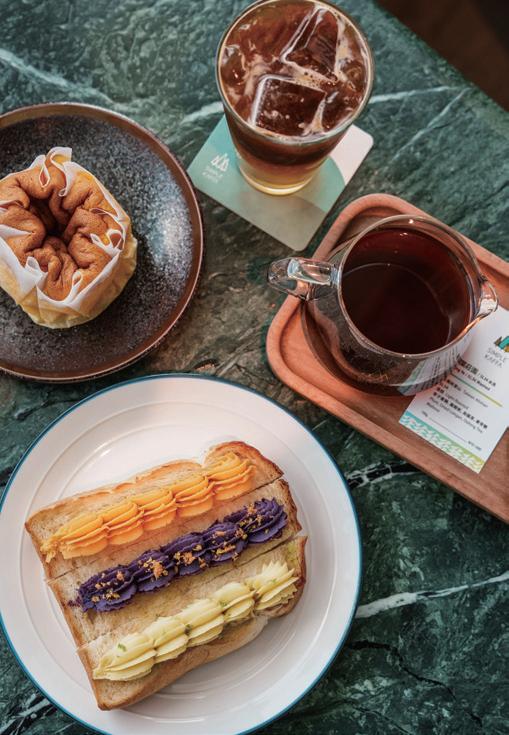
“We never serve a bean until we’ve tried it thoroughly, so we chose that one specifically,” explains Liu. “For the Alishan, you want to fill the cup about one-third of the way and then take in all of the scents. The Alishan coffees all have oolong tea notes, and it’s very obvious here." Apart from Alishan, Simple Kaffa also sources beans from other areas in Taiwan.
“People are willing to spend a hundred US dollars on fine wine or Michelin-star meals, but they don’t want to spend a lot on gourmet coffee,” notes Krude Lin. “But why not, if it’s a premium product? (In fact), where else can you get the same view as the Taipei 101 observation deck, for the price of a cup of good coffee?”
Coffee is serious business at Simple Kaffa. Founder Berg Wu is a regular on the international competitive circuit, and won the World Barista Championship in 2016 after years of perfecting his brewing techniques, first in Taiwan-based competitions and then abroad. Wu worked as an engineer before entering the coffee world, starting with a bicyclemounted coffee stand from which he would sell coffee around National Taiwan University. He brings that fusion of engineering innovation and entrepreneurial spirit to every Simple Kaffa location.
“Many professional baristas want to focus on coffee techniques, not running a business,” notes Liu. “But to really succeed, a great café needs not only an excellent product but also a focus on service.”



Coffee with a view
Simple Kaffa locations now include their flagship store near the Huashan 1914 Creative Park, which melds the aesthetic of Huashan’s industrial origins with dark wood paneling and funky mismatched chairs. Light pours in from the original factory windows, grounding the luxury of the coffee with a sense of history and place. Simple Kaffa has several other branches, two of them in Taoyuan City, one at the Taiwan High Speed Rail Taoyuan Station, the other at Taoyuan International Airport.
In addition to coffee, Simple Kaffa Sola offers light food and a selection of desserts developed by the dessert department of Team Simple Kaffa. The most famous of these is the “Zhou Zhou,” a mouthwatering honey cake with a wrinkled top and moist crumb, developed by Berg Wu himself. It’s so popular that other cafés have begun imitating it, but only Simple Kaffa offers the original.
SIMPLE KAFFA FLAGSHIP ( 興波咖啡 華山旗艦店 ) (02) 3322-1888
No. 27, Sec. 2, Zhongxiao E. Rd., Zhongzheng District, Taipei City ( 台北市中正區忠孝東路二段 27 號 ) 10am~5pm simplekaffa.com (Chinese) www.facebook.com/simplekaffaflagship
SIMPLE KAFFA SOLA ( 天空興波 ) (02) 8101-0099
88F, No. 7, Sec. 5, Xinyi Rd., Xinyi District, Taipei City ( 台北市信義區信義路五段 7 號 88 樓 ) 10am~8pm Reservation: tinyurl.com/ycxp6z8x




More than one Taiwanese coffee titan has taken the world by storm. While Simple Kaffa’s Berg Wu is a veteran of the World Barista Championship competitions, VWI founder Chad Wang reached international coffee fame when he won the World Brewing Competition in 2017. Wang then chose to share his talents with local coffee aficionados by opening a café near the Taipei Metro's Zhongxiao Fuxing Station. Wang believes that water is the most crucial element in determining the quality of a cup of coffee. As such, VWI stands for the three stages of water: Vapor, Water, and Ice.
Located in one of the most upscale neighborhoods in Taipei, VWI blends timeless aesthetics with some of the best coffee in the city. Floor-to-ceiling windows lined with low chairs and tables overlook the profusion of trees and plants in a local park. The quiet lane it sits on offers an escape from main-road traffic. Cool white walls are juxtaposed with cane-backed chairs, steel counters, and wood tables.
VWI’s offerings change seasonally, but each single-origin bean is offered under four tiers: Basic, Select, Limited, and Unique. Signature VWI blends fall under one of these categories, as do any Taiwanese beans. Their signature blend has a nutty flavor with a touch of stone fruit emerging as it cools in the textured glass cup. Their current Limited selection has a brighter flavor, with handharvested and carefully selected beans. As with Simple Kaffa, tasting notes are provided with your drink.
Desserts such as tiramisu made with VWI-blend coffee and liqueur-soaked ladyfingers are prepared to as high a standard as the coffee.
VWI BY CHADWANG (02) 8772-8191
No. 16, Alley 4, Lane 251, Sec. 3, Zhongxiao E. Rd., Da'an District, Taipei City ( 台北市大安區忠孝東路三段 11am~7pm vwibychadwang.cyberbiz.co (Chinese) www.facebook.com/vwibychadwang


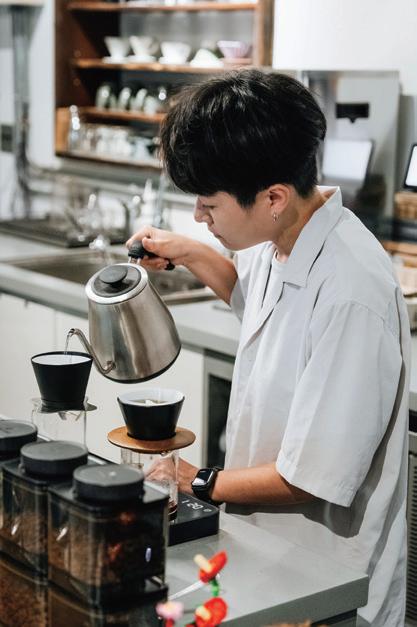


Bean Barn founder Addie Chen entered the industry via a rather non-traditional path. She never drank coffee while young, until she was introduced to the concept of high-end coffee brewing while working as a barista during a working holiday in Australia. Upon returning to Taiwan, this experience helped Chen get a job at a roastery, where she learned to prepare the top-notch beans that make it possible for baristas to work their magic.
“I didn’t start caring about coffee until I found the coffee shop job in Australia,” Chen says. “Then I decided to learn about roasting. It was a bit of an unusual path. Most people just work as a barista for a while, but I decided to stay (in the industry).”
Her connections and expertise in the roasting business propelled Chen to found Bean Barn, a funky café tucked away in the lanes near the Taipei Metro’s Shuanglian Station. The building it’s in was originally a warehouse for a trading firm, and Chen sought to maintain as much of the original interior as possible, including the original terrazzo tile floors and cement walls, complemented by plants, warm wood accents, and a picture window with an iconically Taiwanese view of iron window grilles and 1940s brickwork across the lane. While SanFormosan focuses on localism and Simple Kaffa and VWI aim for luxury, Bean Barn is a cozy nook where one can meet friends over some truly excellent coffee.

Chen’s roasting talents can be tasted in every cup, and tasting notes are provided to patrons on flip cards. For instance, Bean Barn’s limited Colombia light roast is a marvel. With some brews, detecting flavors described in the tasting notes requires stretching the imagination. Does your cup really taste exactly like “green papaya jelly,” or

does it just have a more general fruity brightness? This bean, however, lives up to its description. The notes say “melon,” and it unabashedly gives melon . Their washed Ethiopian Leopard Yirga is more floral, with hints of grape and mango. Desserts such as coffee pudding and matcha cream rolls are flavorful but not overly sweet, matching well with the coffee itself.
Bean Barn is also well-known for their “coffee bentos” –aluminum boxes that contain 16-gram samples of different beans, enough for one cup each. Customers can choose which beans go into their bento boxes. Chen landed on the idea as a slow drinker who had trouble finishing larger bags of beans before they went stale. “It was hard for me to drink so much coffee quickly,” she said, “so I couldn’t figure out which beans I preferred.”
BEAN BARN ( 豆荒良倉 ) (02) 2550-2857 No. 49, Shuanglian St., Datong District, Taipei City ( 台北市大同區雙連街 49 號 ) 11am~7pm beanbarn_coffee_roasters
ENGLISH AND CHINESE Alishan | 阿里山
Berg Wu | 吳則霖
Chad Wang | 王策 Dongshan | 東山
Coffee Industrial Alliance of Taiwan | 台灣咖啡產業策略聯盟
Huashan 1914 Creative Park | 華山 1914 文化創意產業園區
Jinhua Street | 金華街
Krude Lin | 林哲豪
Mt. Chiu-fen-erh | 九分二山
Namaxia District | 那瑪夏區
Sylvia Lin | 林書辰 Taimali | 太麻里
Tieguanyin | 鐵觀音
Xavier Liu | 劉維岡 "Zhou Zhou" | 皺皺

Spend some time in Taiwan and you'll notice peculiar little things that might pique your curiosity. You might wonder: What’s this all about? Why is there a 50-dollar coin stuck on a calculator? Or, why do programmers seem to favor Kuai Kuai brand snacks, but only the green-packaged ones? Let’s unravel some of the mysteries surrounding these everyday beliefs and superstitions.

TEXT AND ILLUSTRATIONS VISION
Acurious local practice involves affixing NT$50 coins to calculators, an action that merges financial aspirations with folk beliefs. This custom stems from the desire to increase wealth, with calculators serving as symbolic conduits for monetary flow. The practice evolved from a humbler version using NT$1 coins, but as aspirations grew, so did the denomination. Now, the NT$50 coin, the highest-value coin in circulation, is the preferred choice. Placement of the coin is crucial. Adherents insist on affixing it to the left side of the calculator, as this is where money “enters” the device. Conversely, placing the coin on the right side is avoided, as it might symbolize the losing of money.
Kuai Kuai snacks have gained a unique status among IT professionals in Taiwan. These locally produced corn-crisp treats have assumed an integral role in a peculiar workplace superstition. The Mandarin for “Kuai Kuai” translates as “well-behaved” or “obedient.” This has given rise to the belief that placing a bag of these snacks near computers can compel the machines to function properly and remain error-free. It’s as if the presence of the “obedient” snacks encourages the computers to follow suit. Interestingly, some insist that only the green-packaged Kuai Kuai snacks are effective, since for computer indicators the color green usually signifies normal operation.

Have you heard of the practice of “eating 100 airplanes” in Taiwan? This peculiar custom, typically observed by young students, revolves around the belief that “consuming” a hundred airplanes will result in a granted wish. The process is entirely imaginative, and unfolds as follows: First, one must spot an airplane in the sky. To “eat” it, extend your arm and make a grasping motion as if catching the aircraft. Once you’ve “captured” the plane in your fist, another person must tap your hand to render the catch “edible.” You can then pretend to eat the airplane. This ritual is repeated each time an airplane is sighted. Upon reaching the hundredth “airplane meal,” it’s said that you may make a wish, which, according to popular belief, is certain to come true.


Have you ever noticed the use of charming little sachets, typically red or yellow, adorned with a red string and the Chinese characters 平安 ( ping an)? These popular talismans are common in Taiwan, and often attached to vehicles, bags, and other personal belongings. Known as ping an fu, or “peace and safety charms,” these sachets serve a deeper purpose than mere decoration. They are believed to offer protection against evil spirits while ensuring peace and safety for their bearers. Readily available at many local temples, these charms embody a fascinating aspect of Taiwanese folk belief. Interestingly, the power of these talismans is not considered innate. To “activate” their protective properties, a specific ritual must be performed, which involves using the temple’s main incense burner. The bearer must hold the charm over the incense ashes and move it in a circular motion three times. This is believed to channel the divine power of the temple’s main deity, who will be looking directly at the censer, into the charm, imbuing it with protective energy.
Another common item you might see being ritually passed over an incense burner’s ashes is a red string, but this will be no ordinary cord. Blessed by a temple’s deity, the string is believed to bestow protection, health, and good fortune upon its bearer. Of particular interest is the red string blessed by Yue Lao, the god of marriage and love. At temples where Yue Lao resides, such as the renowned Taipei Xia-Hai City God Temple, devotees who have sincerely prayed for a marriage partner may receive this auspicious string. According to folklore, Yue Lao has the power to identify suitable matches and symbolically bind destined couples with an invisible red cord. The red string is typically enclosed in a small sachet, which is then kept by the bearer in a wallet or purse, who patiently awaits the miraculous appearance of their fated partner.
ENGLISH AND CHINESE "eating 100 airplanes" | 吃 100 架飛機 Kuai Kuai | 乖乖 ping an fu | 平安符
red string | 紅線 Taipei Xia-Hai City God Temple | 台北霞海城隍廟 Yue Lao | 月老


A long-standing recycling business in Hsinchu City is exploring innovative ways to reuse discarded glass and introduce the circular economy of glass to the Taiwanese public by creating cultural spaces and offering hands-on glassmaking experiences.

Hsinchu City in northwest Taiwan has been renowned for its glass industry since the Japanese occupation period (1895~1945). The city’s first glass company was established in 1939, leveraging the area’s abundant silica sand, lime, and natural-gas resources to produce high-quality glass products. The 1950s saw rapid growth in the local glass sector, with factories built to supply glass for lamps and other industries. Enterprises later expanded into consumer products for international markets, including gifts and decorative items.
The largest glass corporation of the time, Hsinchu Glass Manufacturing Co., was founded in 1954. While primarily producing flat glass, the company opened a glass art department in 1960, marking the beginning of a thriving period for glass craftsmanship in the Hsinchu area. This golden age of glass art lasted until the late 1980s/ early 1990s, after which the local industry entered a period of decline. Concurrently, other industries began to gain prominence, propelled by the establishment of the Hsinchu Sciencebased Industrial Park (now called the Hsinchu Science Park) in 1980.
For those intrigued by this fascinating history, the Hsinchu City Glass Museum is a great place to start. Housed in a 1937 Japanese-era building within picturesque Hsinchu Park, the museum showcases the history and process of glassmaking, with exhibits featuring exquisite examples of glass art.
Right next to the museum is a modern three-story building you can visit to further delve into the world of glassmaking and glass art. It is home to the Spring Pool Glass Studio + The Pool , which was created to allow visitors to experience handson glassmaking (first floor), purchase fine glass art creations by talented designers (second floor), and enjoy fine coffee and cake (third floor).

In the third-floor café at this cultural space, Travel in Taiwan recently interviewed T. A. Wu , the visionary behind this stylish venue and son of Wu Chun-chi, founder of the Spring Pool Glass Industrial Corporation.
Spring Pool, established in 1961, specializes in large-scale glass recycling. The company processes about 100,000 tons of glass annually, transforming waste into new products. With six factories and 200 employees, the enterprise recycles 50~70% of Taiwan’s total glass waste.
Knowing the challenging nature of the business and its slim profit margins, Wu Chun-chi had hoped his son would pursue a career in a different industry. Initially, T. A. Wu embarked on a promising path, first studying in the UK and then going to work for Taiwan Semiconductor, the prominent global leader in advanced microchip production. However, concerned about his father’s advancing age and the potential closure of Spring Pool, he decided to return to the family business to inject fresh energy and diversify operations, ensuring the company’s continued growth and relevance. From the beginning, he wished to let more people know about glass recycling and create new value. “I learned a lot during my time at Taiwan Semiconductor, but I realized in 2012 that my father’s business needed transformation.”

After initially focusing on the development of new products for the company, such as new building materials, in 2017 he launched the W Glass Project , aiming to merge recycling with innovative creation. The project’s first success was the “143 One Mouthful Beer Glass,” a simple yet symbolic item deeply rooted in Taiwanese culture. This 143ml glass, perfect for a mouthful of beer or juice, is commonly used in typical Taiwanese restaurants. Introduced during the Japanese era to moderate alcohol consumption amid resource scarcity, the glass has become a cultural staple. By successfully producing this iconic item from recycled materials, Wu’s project garnered numerous orders. The glass was thereafter styled in various ways, laying the groundwork for further expansion of his project.
Collaboration with leading product designers has been crucial to the success of the W Glass Project. In 2019, for example, the award-winning Taiwan design firm HMM created the amber-colored, wave-shaped W Glass. This piece exemplifies the project’s philosophy of embracing imperfections inherent in recycled glass, such as color irregularities and internal bubbles. Another notable collaboration resulted in Darts by André, designed by Taiwanese Michelin-starred chef André Chiang. This versatile set of six stackable glass plates in varying sizes is suitable for both home meals and picnics. These and many more partnerships highlight the project’s commitment to merging sustainability with innovative, functional design.
Wu has also expanded his collaborative network to include various designers, artists, and businesses, for example partnering with the prestigious Simple Kaffa group (see page 40), to create an array of sparkling glass art in addition to functional pieces.

The creation of the above-mentioned The Pool in Hsinchu and another The Pool in the city of Tainan (located on the top floor of Tainan Art Museum Building 2) represents more accessible and permanent manifestations of Wu’s vision. Both spaces, designed by the renowned Taiwan firm Seed Spacelab, feature airy, minimalist aesthetics predominantly expressed in white. Glass and other items from recycled materials are central to both venues. In Hsinchu’s The Pool, glass objects adorn a staircase, and a large bar is constructed from glass blocks. Tainan’s version displays glass art objects and serves food and drinks in recycled-glass containers. A unique culinary highlight is the grapefruit-flavored braised pork jelly, which surprises diners with its glass-like appearance.
The “pool” located on the third floor of the building next to the Hsinchu City Glass Museum is a simple, square space with large windows that let in ample sunlight, and offer visitors a splendid unobstructed view of the old banyan trees in the park outside. Excellent coffee and cake are served here, and the center of the room is used as an exhibition space, showcasing various displays; during our visit, there was an exhibition introducing a photography
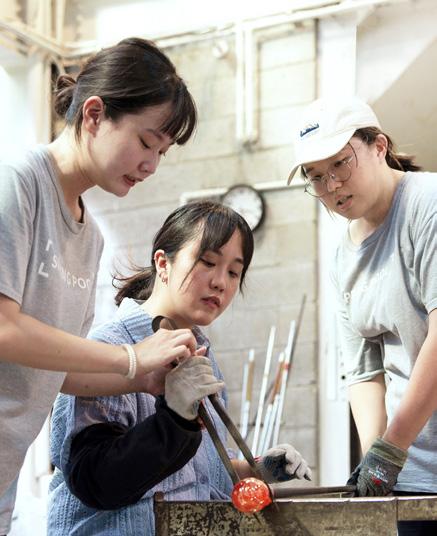
book. Says Wu, “The idea is, while you have a cup of coffee you can also experience part of the circular economy of glass.”
On the second floor of the same building, you can purchase products made from recycled glass and other materials, crafted by designers and artists collaborating with the W Glass Project. Finally, on the ground floor, enjoy a handson experience in glass crafting. There are two areas: one for creating larger glass objects and another for creating smaller items such as spoons or cute animal figurines. “This is a place,” says Wu, “where you can experience glassblowing yourself, or just watch it. It’s a great place to learn about glass creation. About 80% of all people don’t know how glass is made.”

Following our conversation with Wu, we explored the DIY area, where we learned to craft colorful patterned glasses. Attentive staff members guided us through each step (English instructions are available if needed). Though initially daunting, working near furnaces exceeding 1,000 degrees Celsius proved to be a safe and exhilarating 15-minute experience. The highlight was undoubtedly blowing through a long metal pipe to shape the molten glass.
The glassmaking sessions are priced at NT$980 per person, with a range of customization options offered for the workshop, including various shapes, patterns, and colors. Your finished piece requires about a day to cool and set. Participants can either arrange courier delivery in Taiwan or collect their unique creations the following day.
SPRING POOL GLASS STUDIO + THE POOL (新竹春室)
No. 2, Sec. 1, Dongda Rd., Hsinchu City (新竹市東大路一段2號) (03) 561-1039
www.glasspoolstore.com www.facebook.com/springpoolglassstudio

ENGLISH AND CHINESE 143 One Mouthful Beer Glass | 143一口啤酒杯
André Chiang | 江振誠 Glass Pool | 春玻 Spring Pool Glass | 春池玻璃
T.A. Wu (Wu Ting-an) | 吳庭安 W Glass Project | W春池計畫 Wu Chun-chi | 吳春池




Taipei City FOOD
Grand Hotel Taipei
圓山大飯店
Enjoy a glass of wine specially made for heads of state and breathe in the air of history and culture at Meet bar.
Based on ideas by Madame Soong Meiling, the Grand Hotel Taipei was established in 1952. The first five-star hotel in Taiwan, it became a must-stay hotel for distinguished guests visiting the island and a cultural landmark of historic significance. The Chinese name of Meet bar is a play on words. Mi Dao sounds like “To Find” as well as “Secret Passage.” The bar combines old and new spaces and thus symbolizes the Grand Hotel’s presence and past. From Meet bar walk through the historic Secret

East Passage to find a secret garden and take a look into the Old Residence of Kung Ling-wei (daughter of Nancy Soong Ai-ling). Then return to the bar, order a unique “Red House” cocktail and reminisce about times gone by. Meet bar reservation hotline:
9am~4pm Tel: (02) 2886-1818 ext. 1281 4pm~1am Tel: (02) 2886-1818 ext. 1998

No. 1, Sec. 4, Zhongshan N. Rd., Zhongshan District, Taipei City ( 台北市中山區中山北路四段一號)
Tel: (02) 2886-8888 Fax: (02) 2885-2885 www.grand-hotel.org
台北怡亨酒店
Setting the benchmark in terms of style and inspiration, staying at Hotel Éclat Taipei is no ordinary experience. Situated in the fashionable district of Da'an, this charismatic boutique hotel with its avant-garde design, attentive service and astounding modern art collection is nothing short of leading-edge.



No.370, Sec. 1, Dunhua S. Rd., Da'an District, Taipei City 106, Taiwan ( 台北市大安區敦化南路一段370號)
Tel: (02) 2784-8888 Fax: (02) 2784-7888
Reservation: (02) 2784-8888 https://www.eclathotels.com/taipei
遠雄悅樂旅店
At OLAH POSHTEL, we break the boundaries between travel and everyday life. This chic poshtel blends local culture, versatile shared spaces, self-service amenities, and in-depth travel activities with modern design, offering travelers from around the world a fresh interpretation of "travel as a way of life." In 2024, it was also selected as one of Taiwan's Leading Boutique Hotels. Enjoy 24-hour shared spaces like the Cozy Corner, Book Room, and Rooftop Garden. Indulge in free snacks, popcorn, coffee, and late-night ramen. Explore with our stylish maps and shared bikes. We also offer free rentals of neck massagers, foot baths, and baby supplies, ensuring a carefree trip for young travelers and families. Share everything, enjoy endlessly!

Yilan County
The Lealea Makauy Ecological Park, which includes the Cilan Forest Recreation Area, the Mingchi Forest Recreation Area, and the Divine Trees Garden, covers an area of more than 2,500 hectares. Teeming with wildlife, the park is Taiwan's largest broadleaved forest and juniper tree area. A world of natural wonder with over 365 animal and 231 plant species, this is a place of extraordinary scenic beauty, where the air is clean and invigorating. European-style villas and forest cabins offer visitors an unforgettable, leisurely, and comfortable accommodation experience within the park.
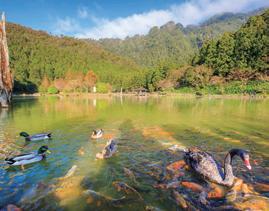
No. 6, Sec. 4, Taiya Rd., Taiping Village, Datong Township, Yilan County ( 宜蘭縣大同鄉太平村泰雅路四段6號)
Tel: (03) 980-9777 makauy.lealeahotel.com
Nantou County
日月潭力麗溫德姆溫泉酒店
Wyndham Sun Moon Lake is located at Sun Moon Lake, the largest natural lake in Taiwan, close to the Ita Thao Wharf. Enveloped by verdant mountains and the ethereal mist of the lake, this location boasts breathtaking beauty. It’s just a short walk to the wharf and the village’s Old Street area. Discover the beauty of the lake by taking a leisurely boat cruise, cycling along the shoreline, or soaring above it by taking the Sun Moon Lake Ropeway. The hotel has 203 rooms, all featuring hot and cold spring water pools. There’s also a public pool and a hot-spring spa center. Dining options include a buffet restaurant, a Chinese restaurant, two bars, and a familyfriendly restaurant with a playground for kids. Wyndham Sun Moon Lake caters to all travel and accommodation needs, ensuring a comfortable and unforgettable stay.
No. 312, Zhongzheng Rd., Yuchi Township, Nantou County ( 南投縣魚池鄉中正路312號)
Tel: (049) 285-0085 wyndhamsunmoonlake.com


OLAH POSHTEL Taichung Station Branch No. 55, Zhongshan Rd., Central Dist., Taichung City | Tel: (04) 2221-7668
OLAH POSHTEL Wenxin Branch No. 339, Sec. 4, Wenxin Rd., Beitun Dist., Taichung City | Tel: (04) 2242-5555
OLAH POSHTEL Hualien Zhongfu Branch No. 122, Zhongfu Rd., Hualien City | Tel: (03) 832-6655 www.facebook.com/OLAHPoshtel www.olah.com.tw

STAY
Taichung City
想窩11餐旅館
Shine World 11 Hotel & Restaurant is well-known for its one-of-a-kind indoor and outdoor play spaces and amenities designed specifically for families. Room types include themed rooms, double suites, double rooms, and quadruple rooms. The indoor play space is a wonderland for kids, complete with a ball pit, slides, a reading area, and a creative block-building area, perfect for fun and learning experiences. The outdoor area includes a 1,300 square meter artificial grass lawn equipped with diverse play structures, providing ample room for children to play and run around. By providing comfortable accommodations and delicious meals Shine World 11 Hotel & Restaurant creates unforgettable and diverse experiences for the whole family.
No. 11, Dongjin 1st St., Shalu Dist., Taichung City ( 台中市沙鹿區東晉一街11號)
Tel: (04) 2632-3111 www.shineworld11.com.tw









